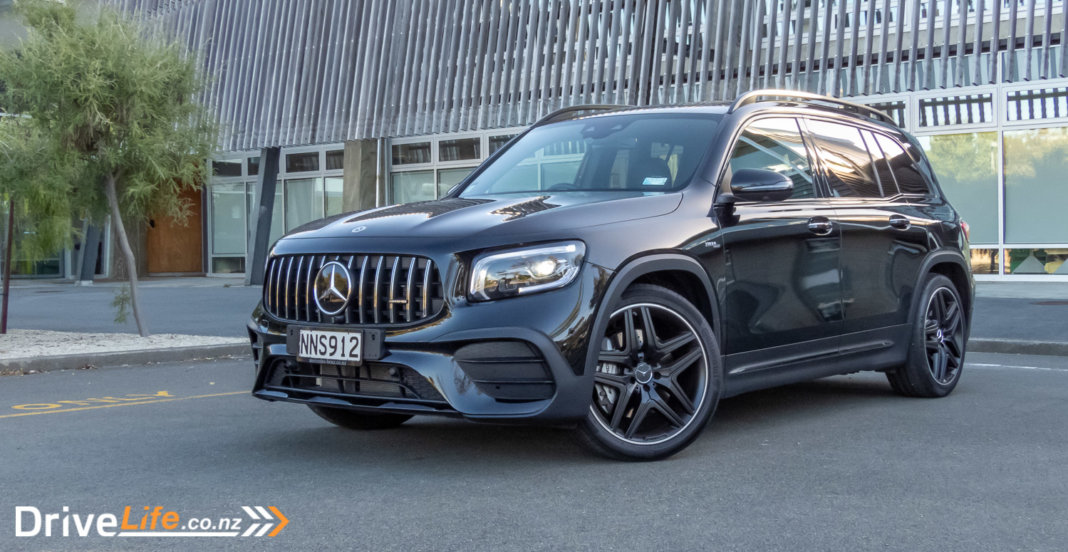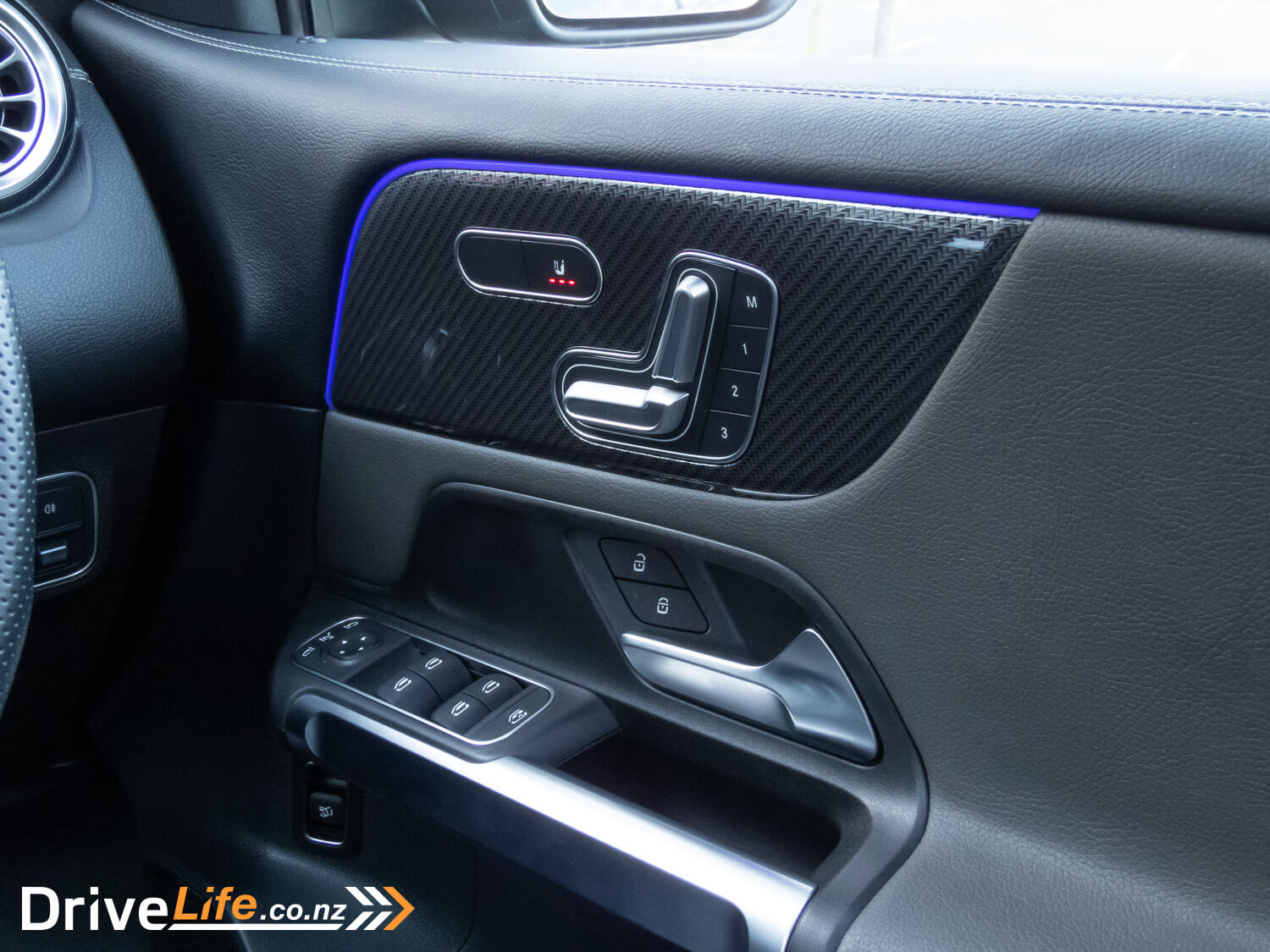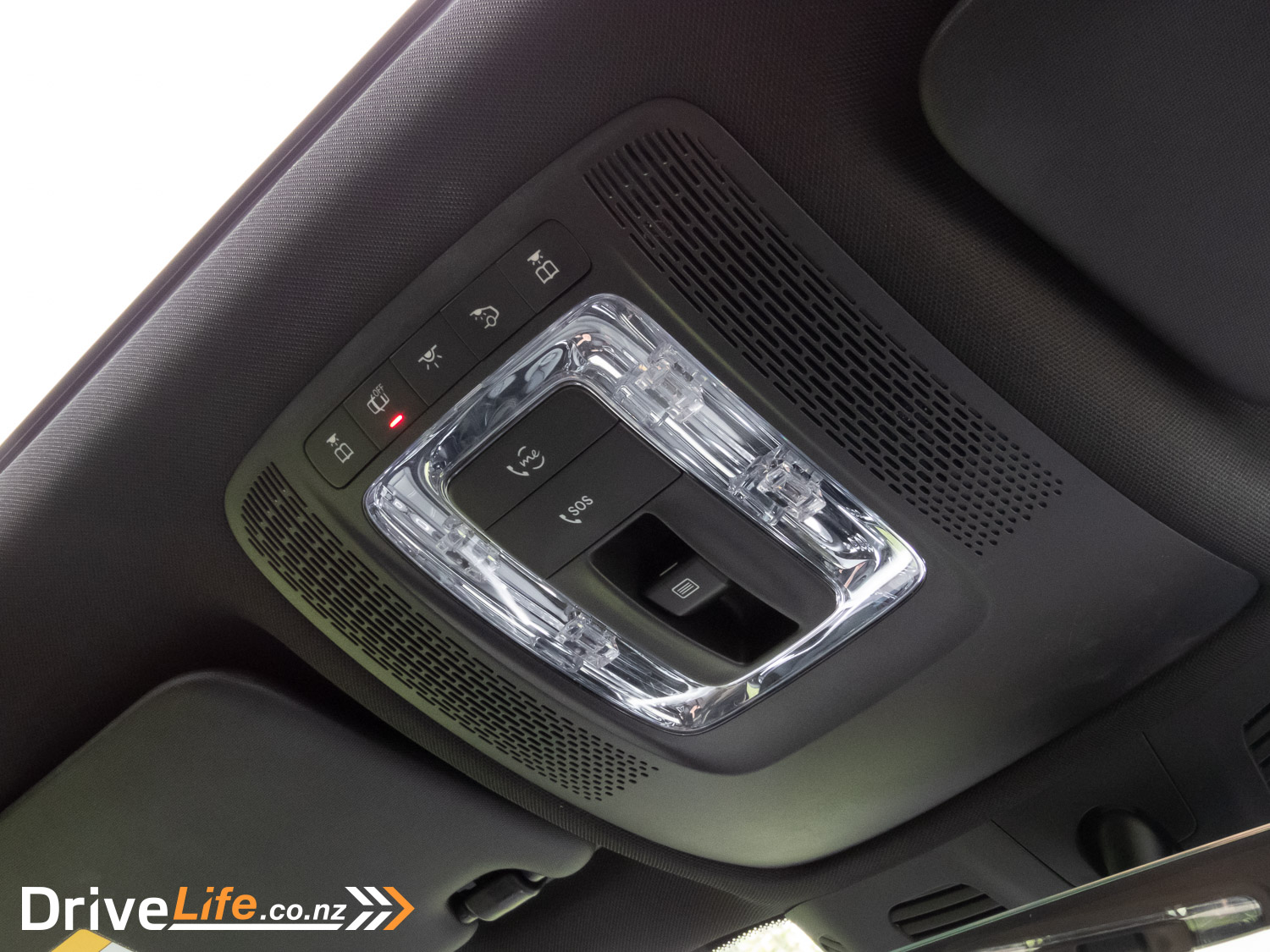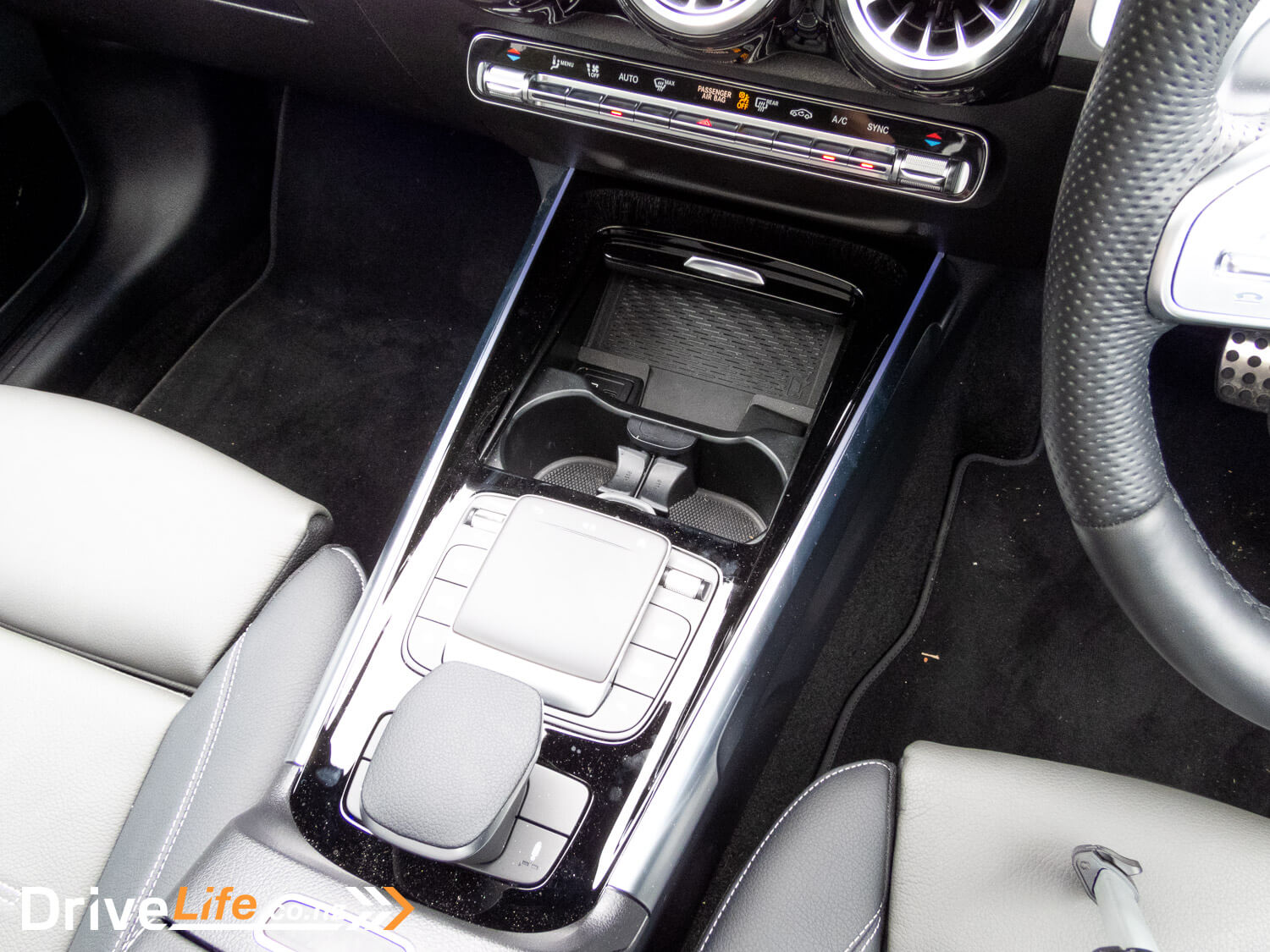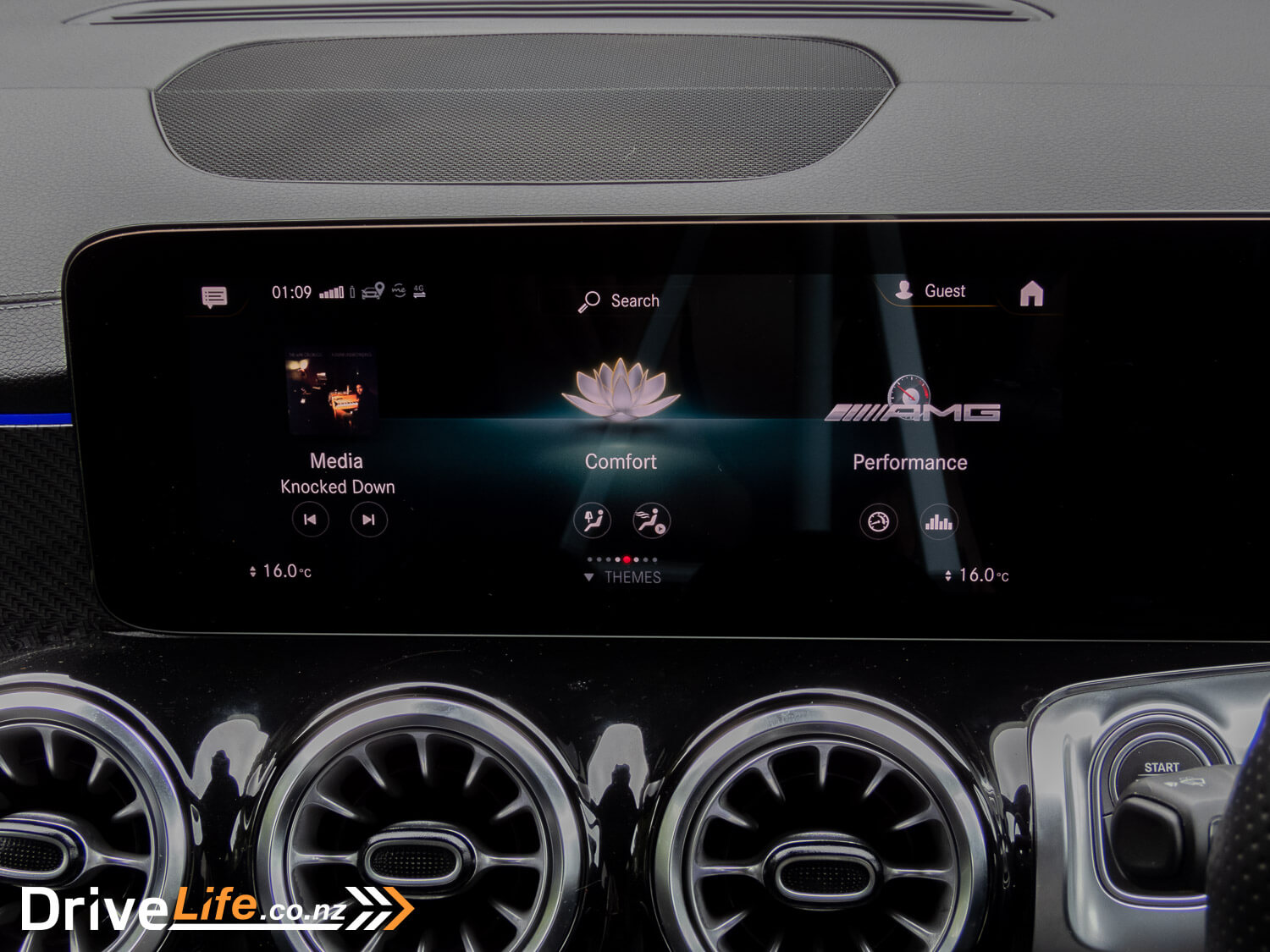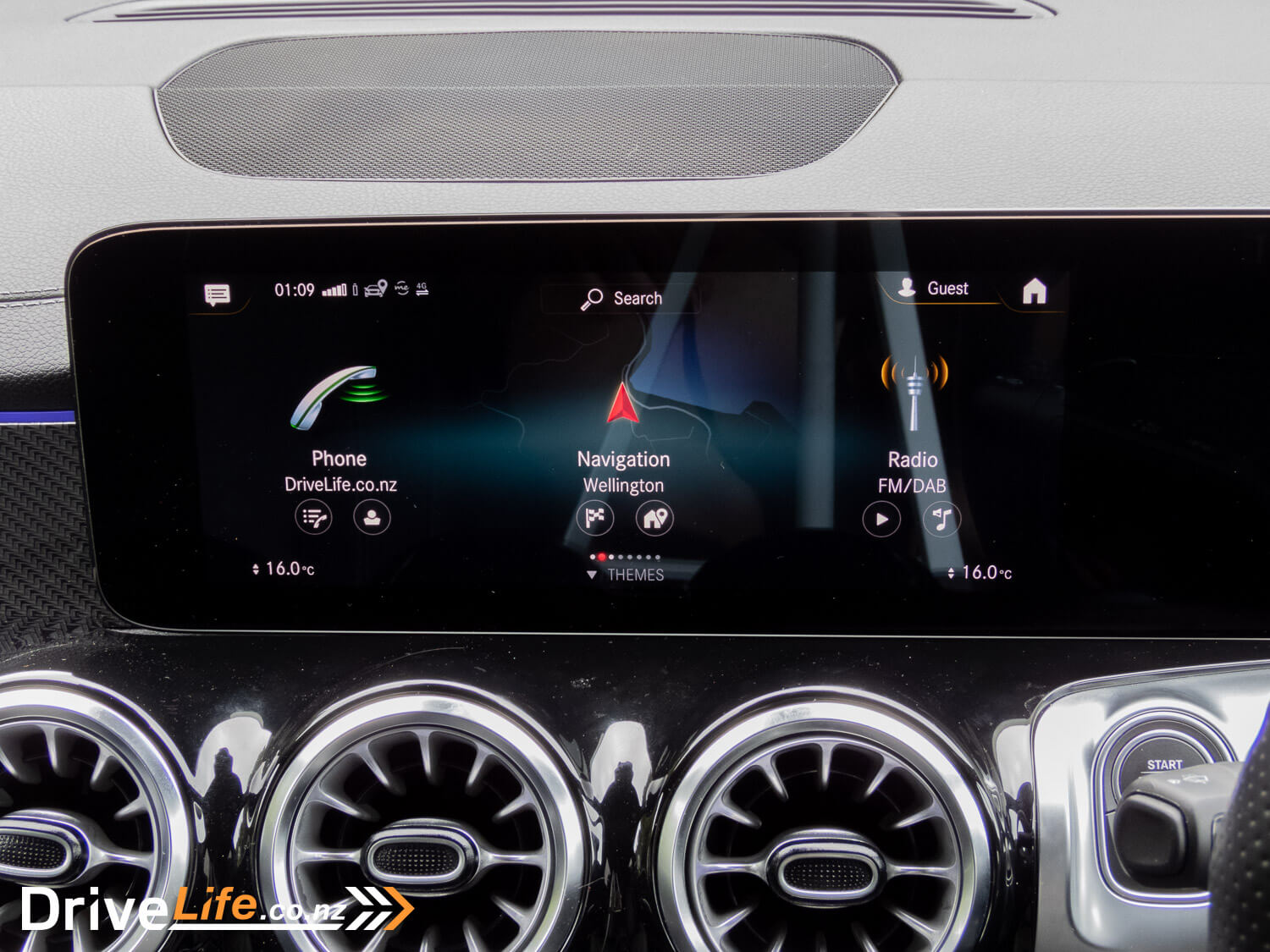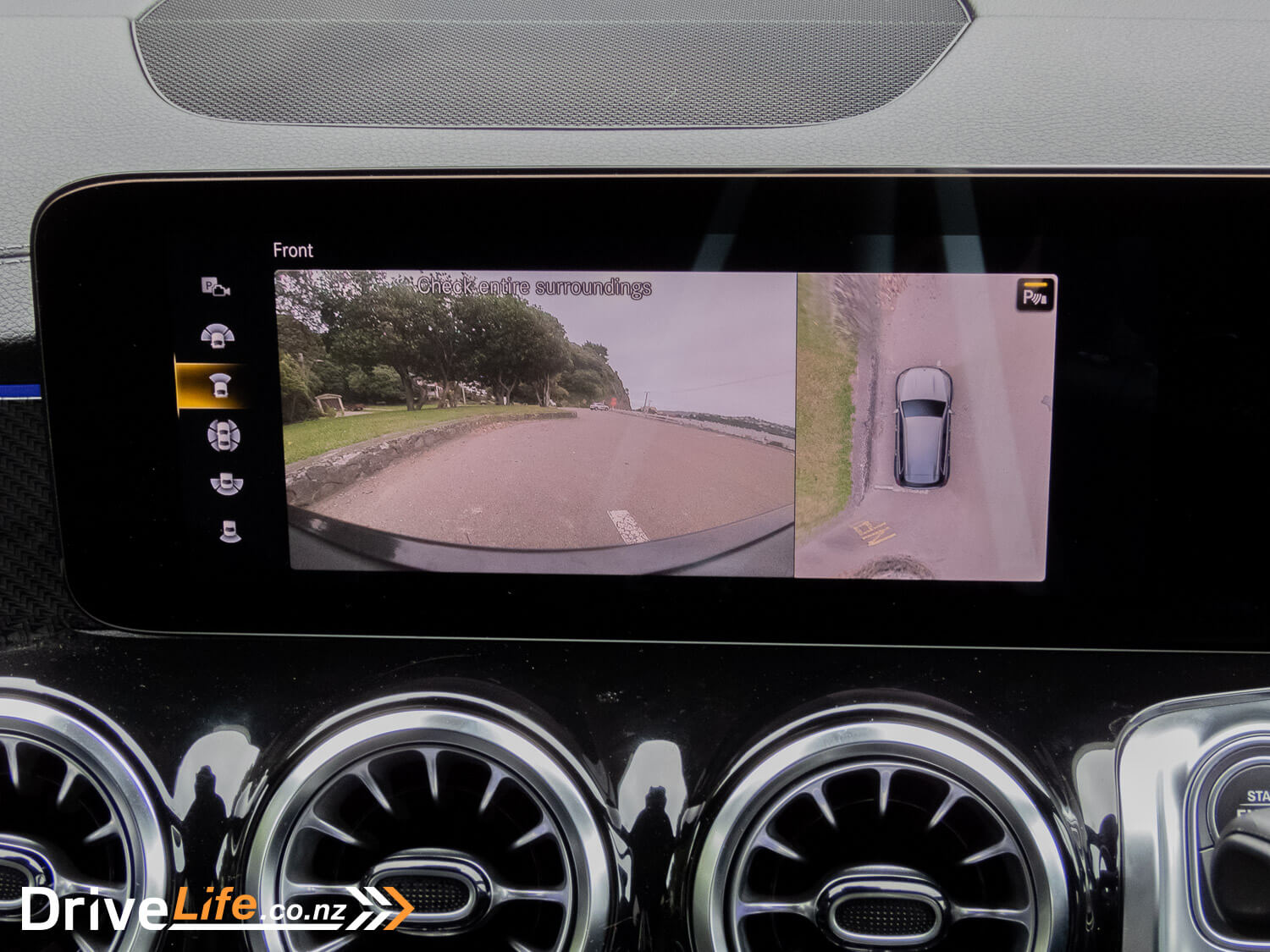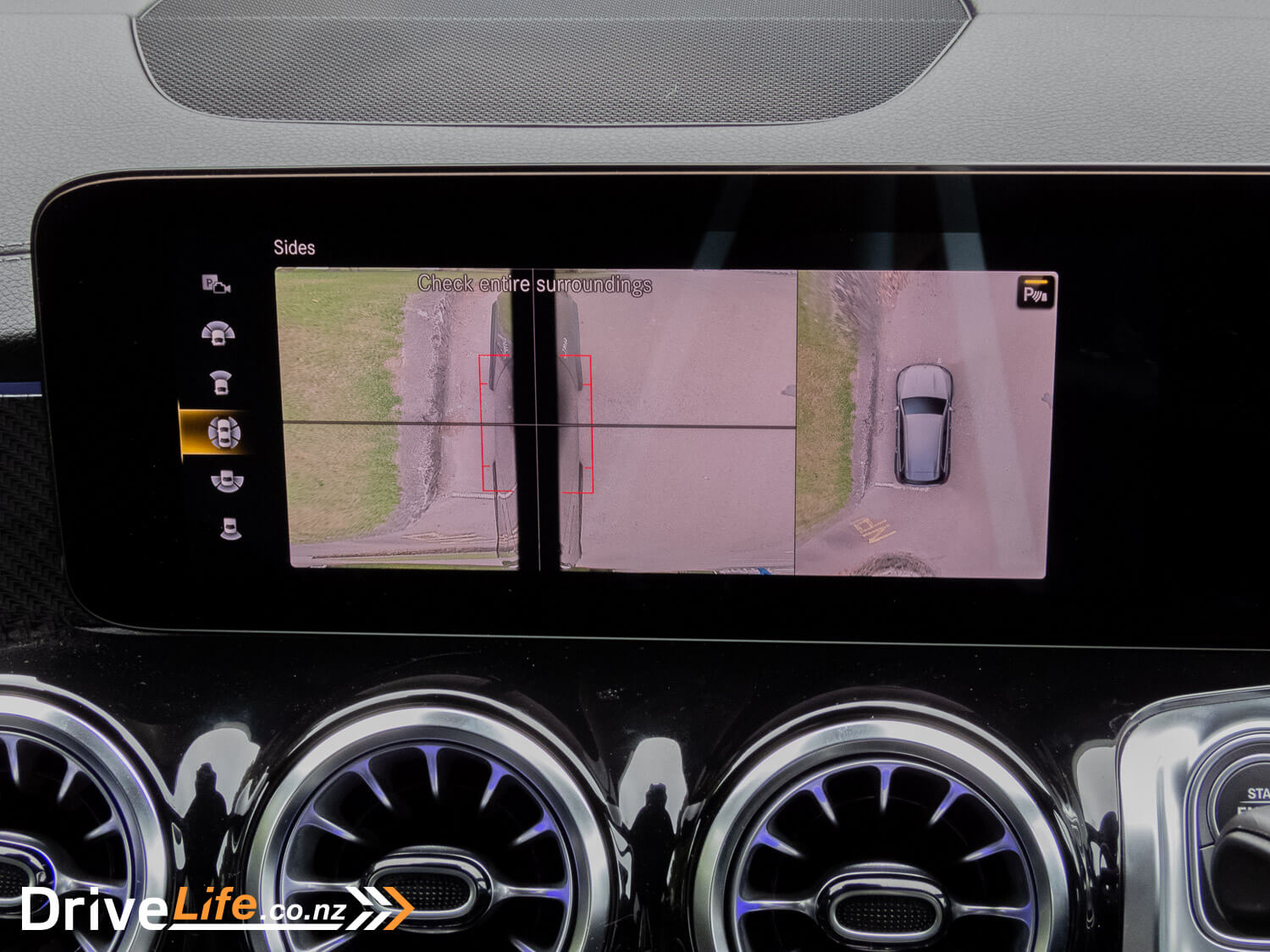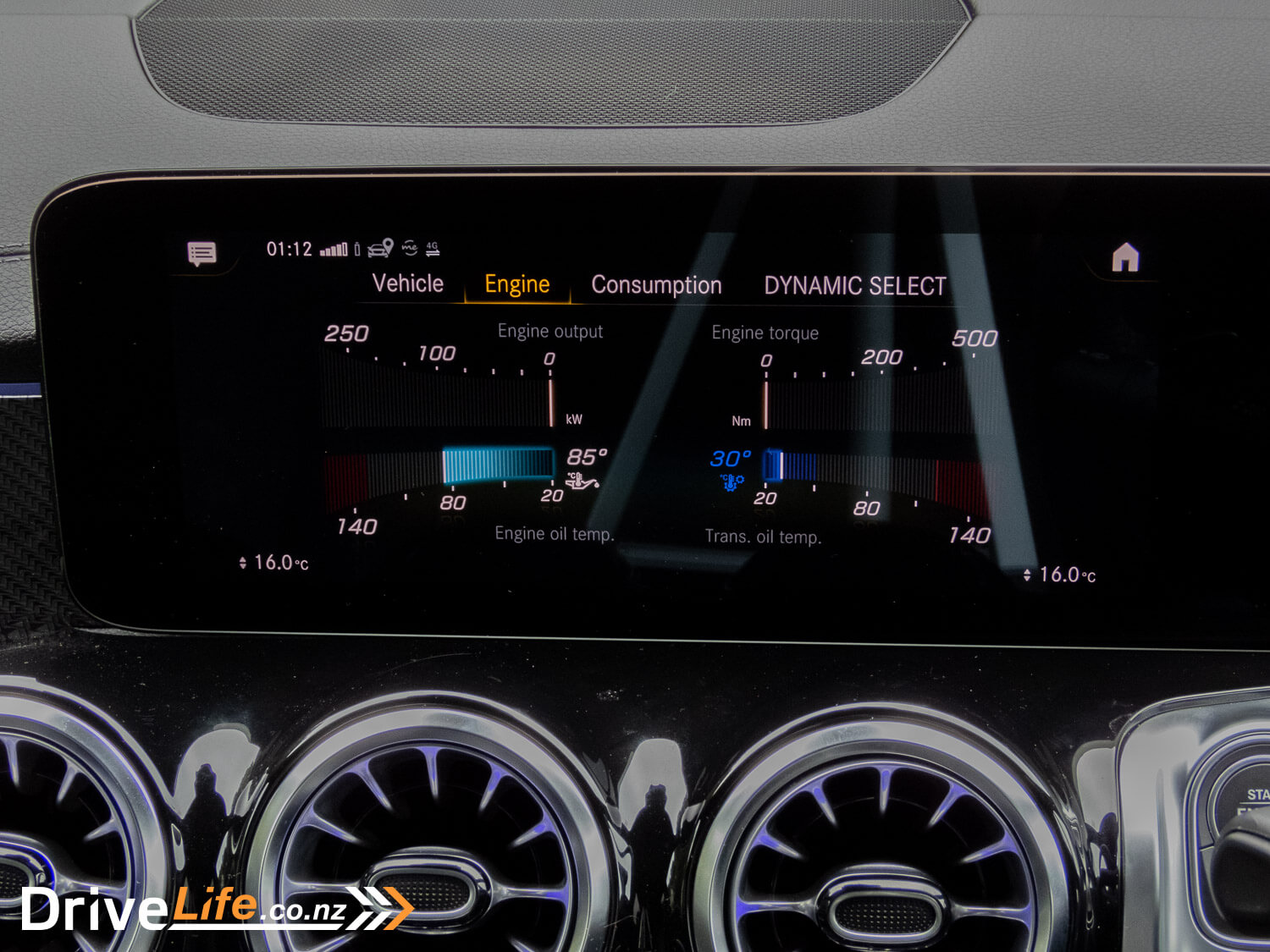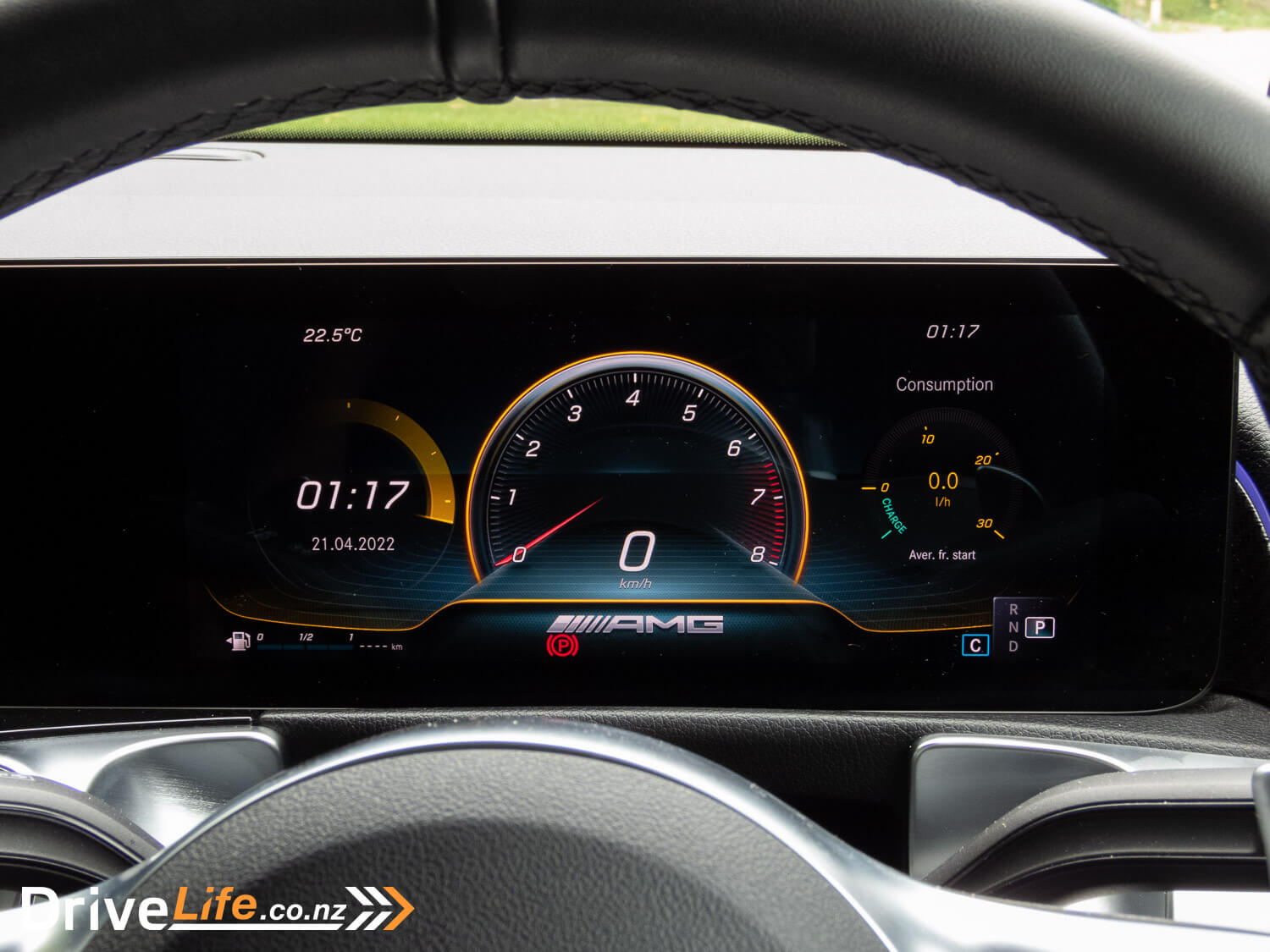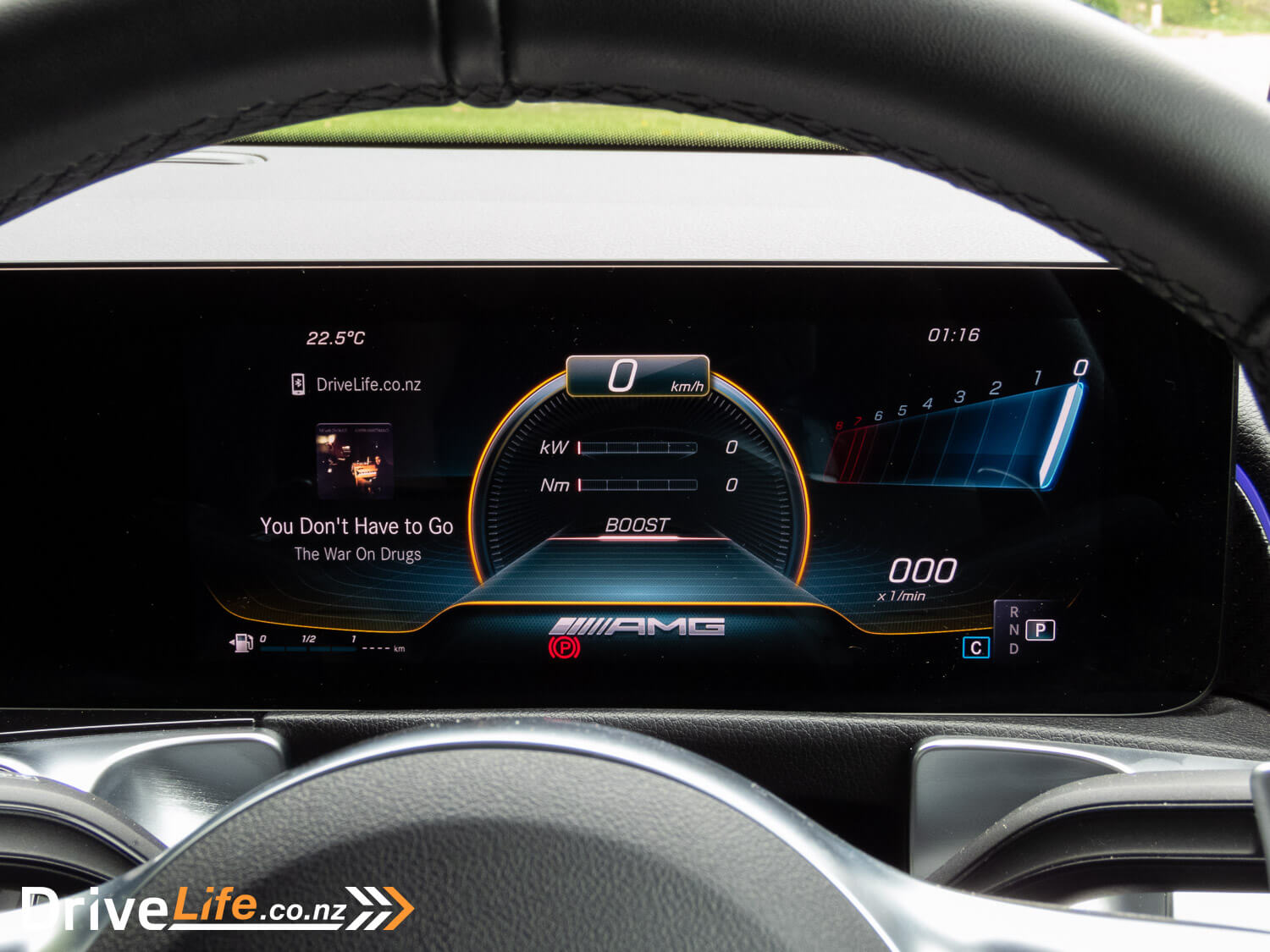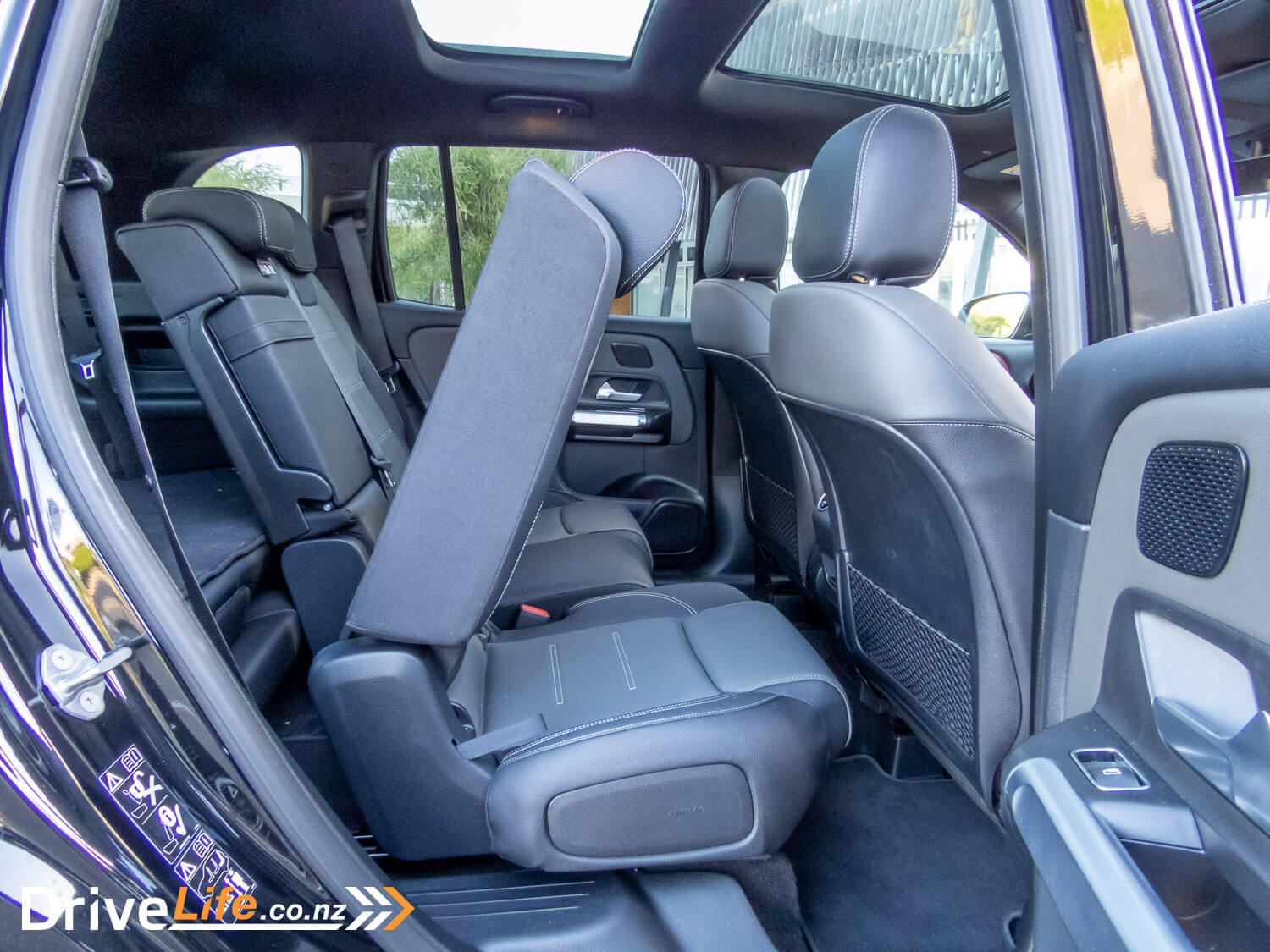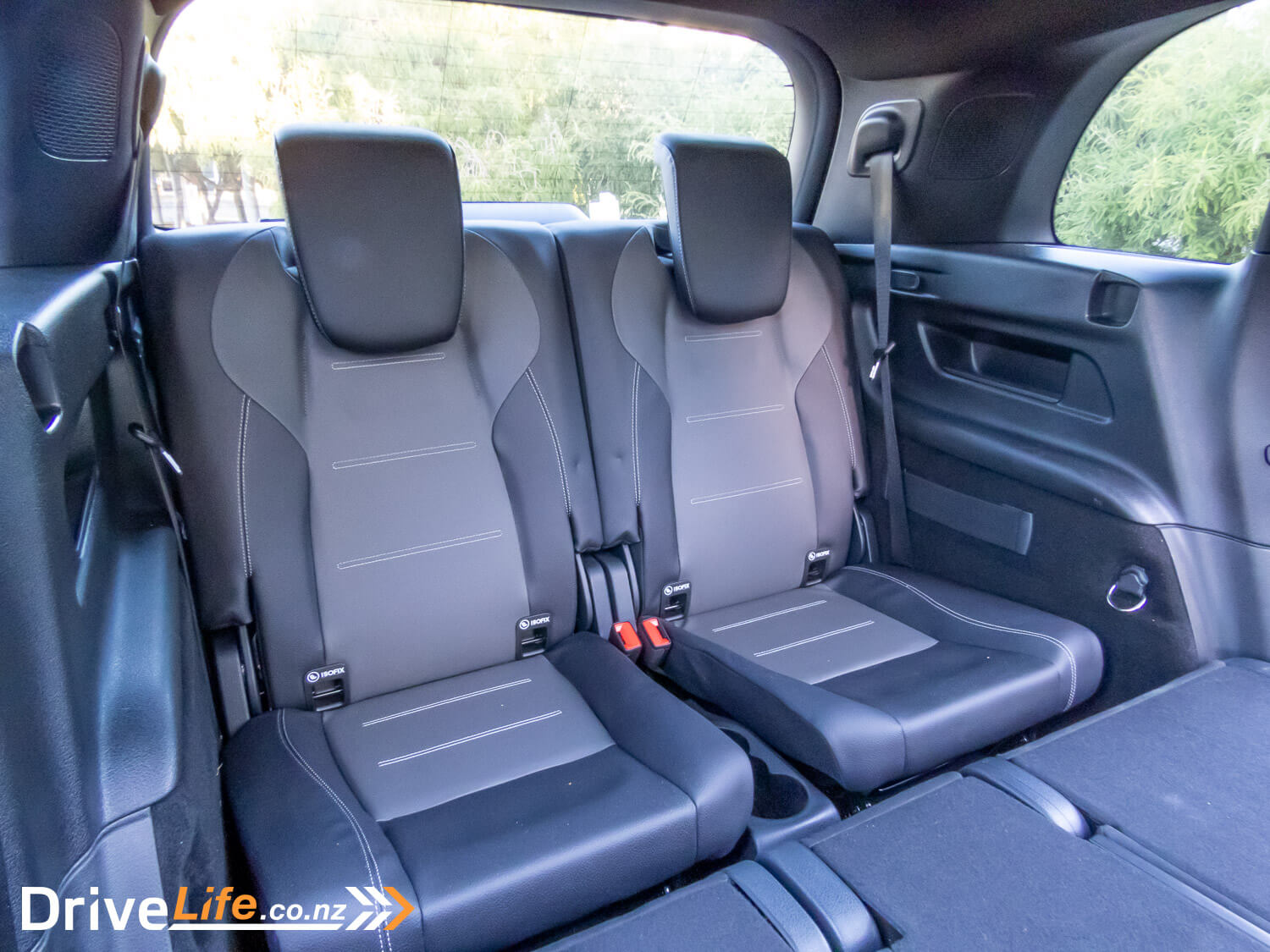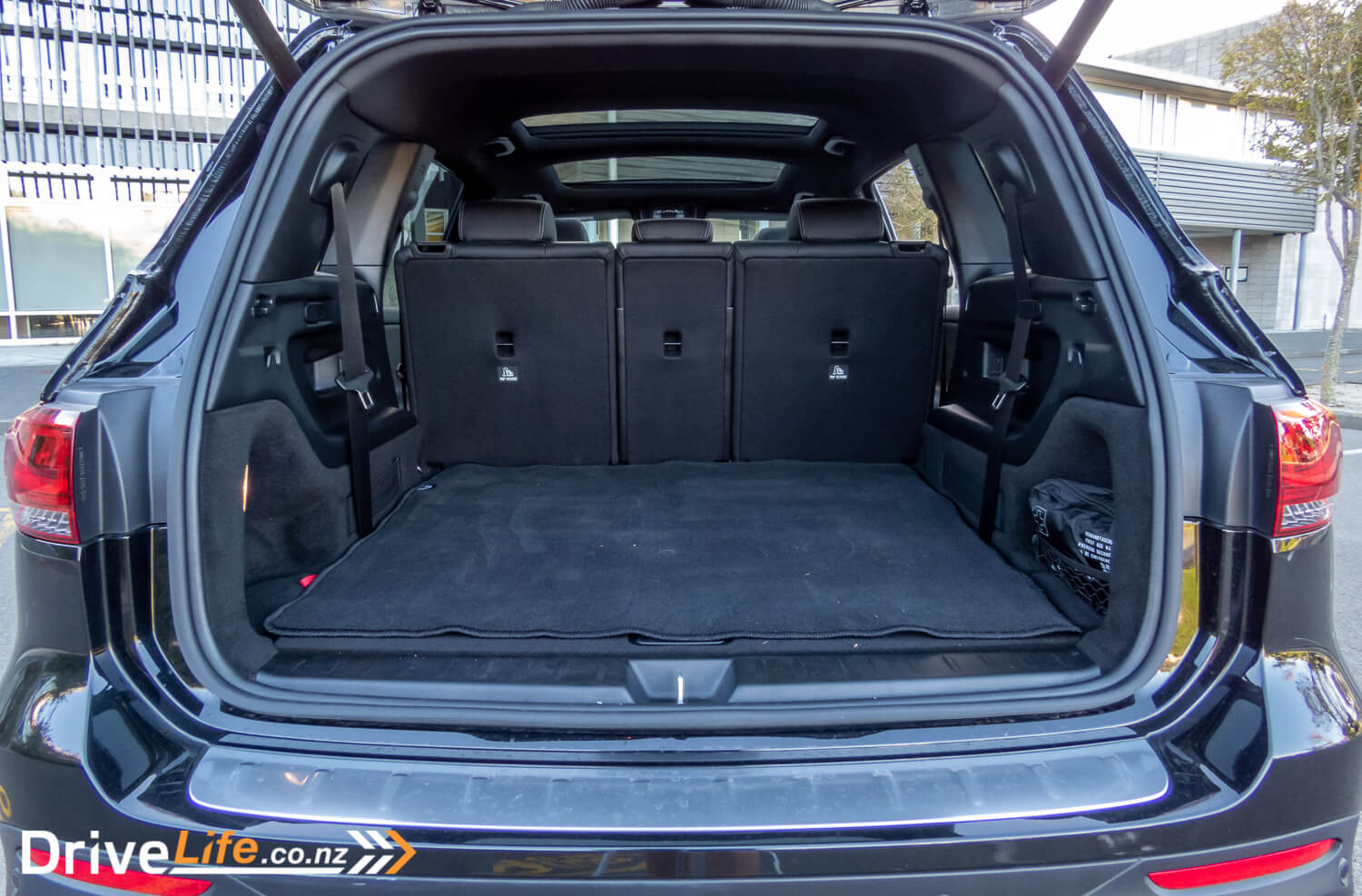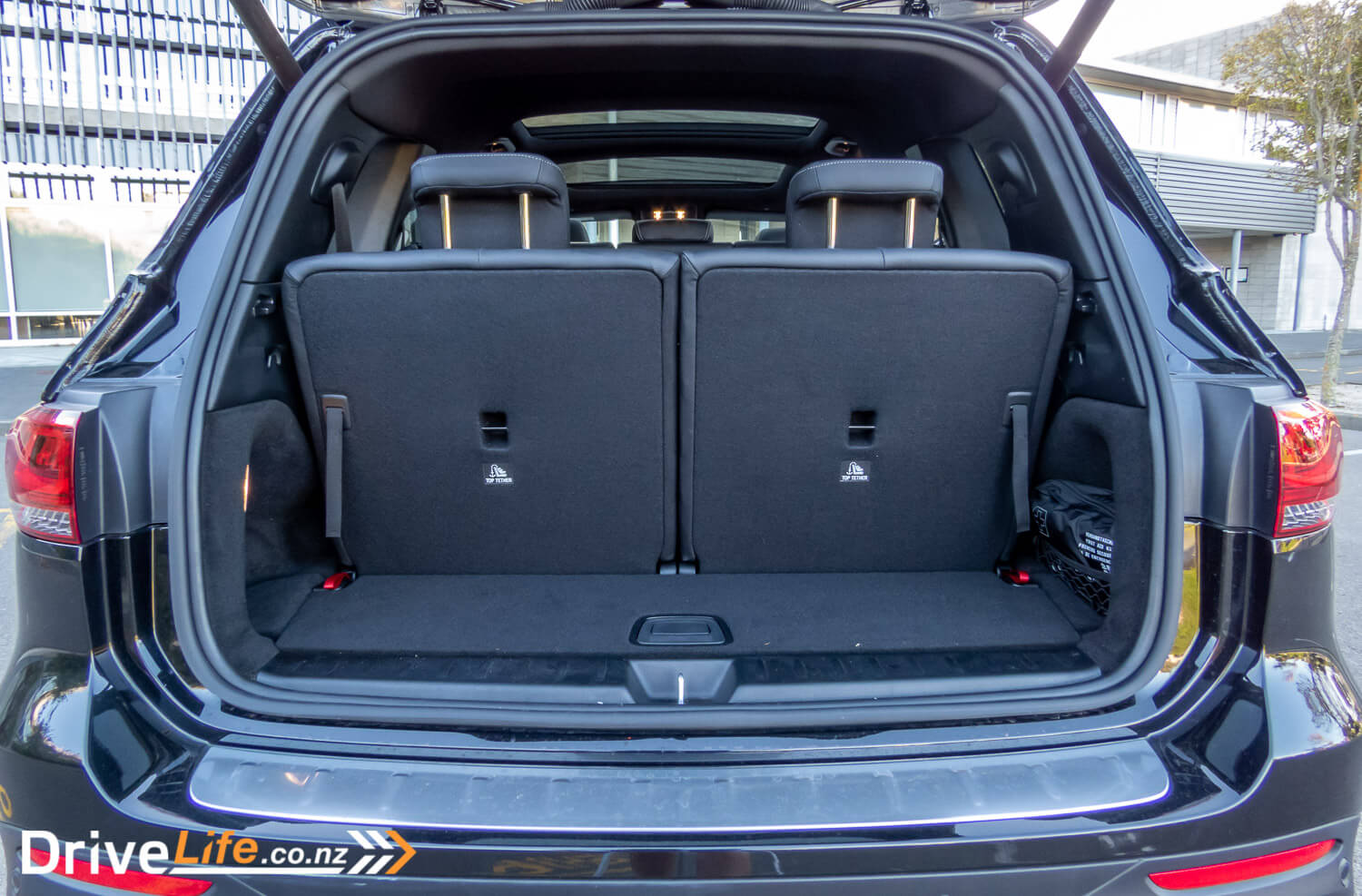AMG. The fabled German tuning outfit from Affalterbach that made their reputation for transforming well-mannered Mercedes vehicles into fire-breathing monsters. Pull alongside a Porsche at the lights, you could almost see the sweat visible from the drivers’ brow after they caught a glimpse of that notorious three-lettered badge.
In 2022, the AMG badge has been watered down a tad. As opposed to all Mercedes-AMG models being fire breathing monsters, they’re now graded in varying levels of spice.
An AMG “35” is the jalapeno pepper of the AMG range. It has enough kick to surprise. An AMG “63” is a ghost pepper, by comparison. It’ll kill you if you’re not used to it.
So, the Mercedes-AMG GLB 35 is a spiced-up small crossover, with 300 horsepower and seating for 7. But, is it any good? Mercedes gave us the keys for a week to find out.
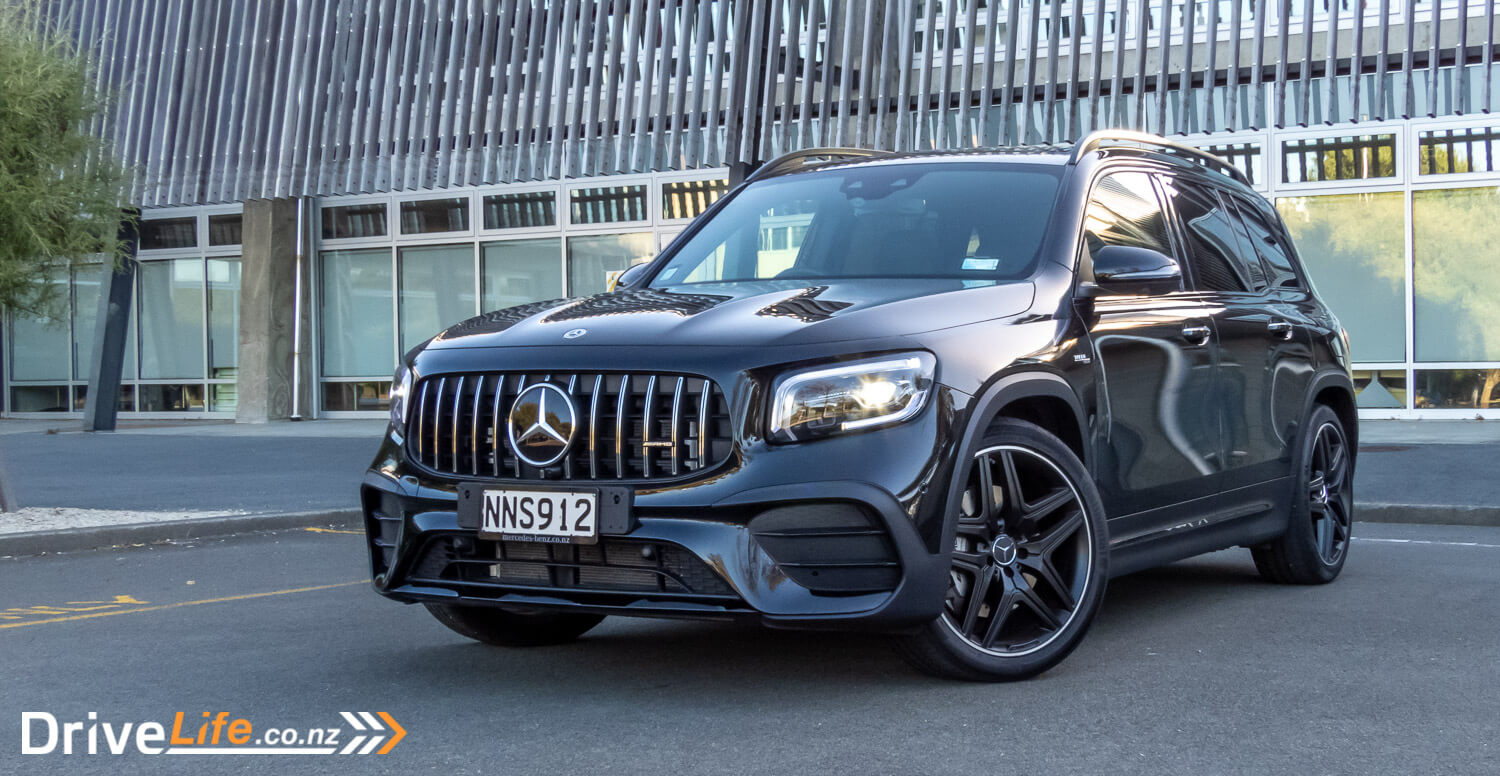
What We Like and Dislike About The 2022 Mercedes GLB 35 AMG
| What we like | What we don’t like |
| Spacious cockpit Good seats Decent noise Handling Mercedes technology | Stiff ride Fuel economy Wide turning circle Infotainment track pad difficult to use Mishmash of interior controls and materials Tight 3rd row Won’t impress an AMG enthusiast |
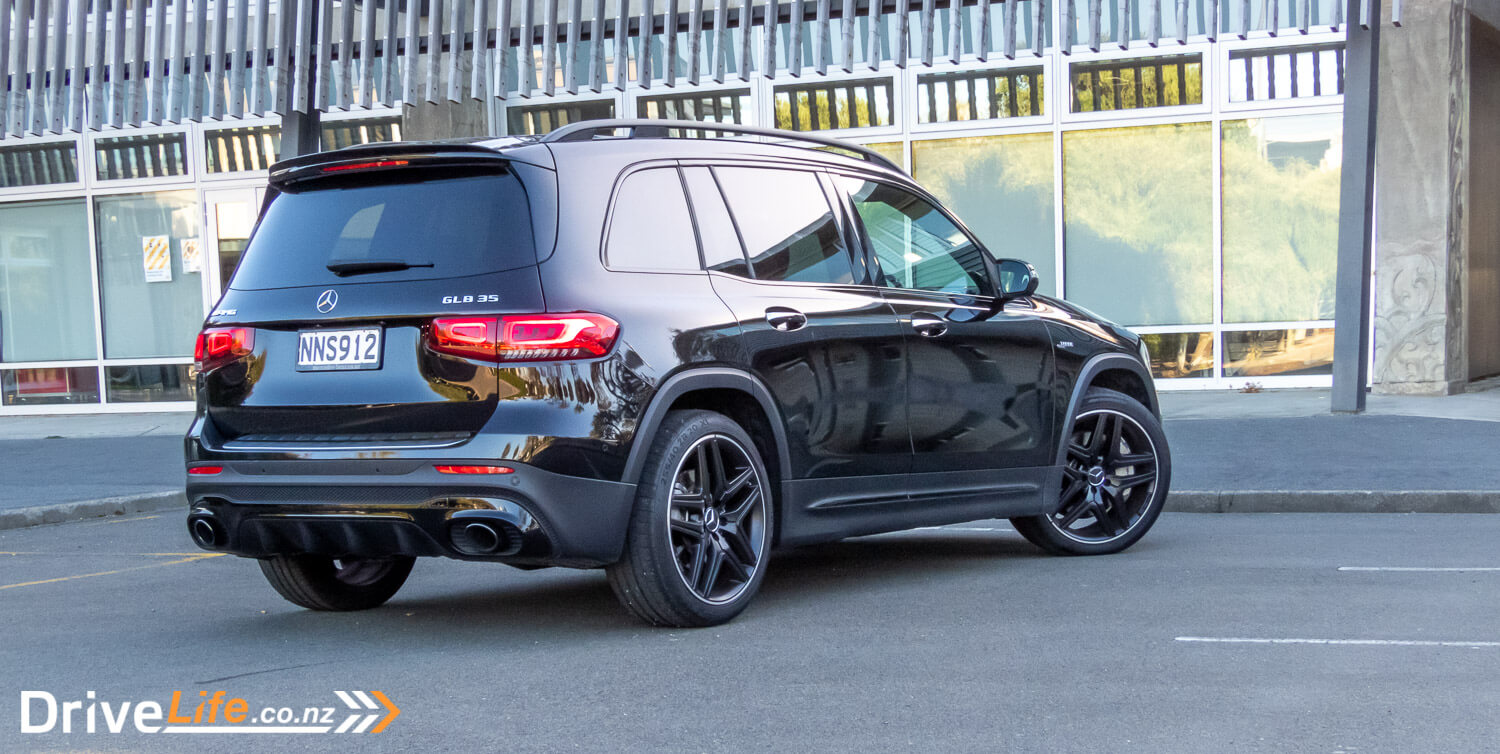
What’s In The 2022 Mercedes GLB RANGE?
There’s three different models in the Mercedes GLB range. First, there’s the entry level GLB 200. The next rung up is the GLB 250 4MATIC. Finally, the GLB 35 AMG sits proudly atop the GLB range.
| Model | Price |
| GLB 200 | $82,100 |
| GLB 250 4-Matic | $96,797 |
| GLB 35 AMG | $114,200 |
The entry level GLB 200 comes with a 1.3-litre, 4-cylinder turbo petrol engine with an output of 120kW of power and a reasonable 250Nm of torque. This model is front-wheel drive only, and has a 7-speed dual-clutch automatic transmission (DCT).
Moving up to the next step, the GLB250 uses a 2.0-litre, 4-cylinder turbo petrol engine that produces 165kW and 350Nm.
The GLB 35 AMG uses the same engine as the GLB250. However, AMG has played with it, and now it pumps out 225kW of power and 400Nm of torque.
Both the GLB 250 and the GLB 35 AMG models are fitted with an 8-speed DCT and are all-wheel drive (AWD).
2022 Mercedes GLB Standard Equipment Highlights
As standard for the GLB 200 range, you receive:
- 19’’ Alloys,
- 9 Airbags
- Mbux Infotainment System With 2×10.25” Screens
- Apple Carplay/Android Auto, Satnav
- 225-Watt 8 Speaker Sound System,
- DAB Radio
- Climate A/C
- QI Wireless Phone Charging
- Auto Dimming Interior Mirror
- Lumbar Adjust For The Driver
- Electric Tailgate,
- Illuminated Door Sills,
- LED Headlamps
- Interior Light Package,
- Reversing Camera,
- Automatic High Beams,
- Active Parking Assist With Parktronic,
- Alloy Roof Rails,
- Electrically Folding Mirrors,
- Auto Wipers,
- Twin Exhaust Tips,
- Active Lane Keep Assist
- Cross Wind Assist,
- Traffic Sign Assist
- Blind Spot Assist
- Keyless Entry and Start
Upgrading to the GLB 250, you get an extra:
- Another style of 19’’ Alloys,
- Heated front seats with lumbar support
- Automatic Climate Control
- Illuminated Door Sills
- Automatic Panoramic Electric Sunroof
- Adjustable Suspension
- OFF-ROAD Engineering Package
- Sports Direct-Steer System
- Larger fuel tank (60L)
Go for the GLB 35, you’ll get all from the GLB 250 and:
- 20-Inch 5-Twin-Spoke Alloy Wheels
- Electric Front Seats With Memory
- Parking package with 360-degree camera
- Interior Assistant
- AMG Exhaust System (With Silent Start)
- AMG High-Performance Brakes
- AMG Performance 4matic All-Wheel Drive
- AMG Ride Control
- AMG-Specific Bodystyling
- AMG Night Package Including Blackened Beltline, Tailpipes, Front Splitter, Exterior Mirrors, Side Sill Panel Inserts And Rear Apron
- AMG Speed-Sensitive Power Steering
- Black Roof Rails
- Privacy Glass
- 2x 90mm Tailpipes
- Multibeam LED Headlamps
- AMG Leather Package
- AMG Performance Steering Wheel
- Carbon Structure Trim
Our test vehicle is fitted with the following options:
- Vision Package (extra $1,190)
- Adaptive High Beams
- Multi-beam LED lamps
- Panoramic electric sunroof
- Cosmo Black Metallic Paint (extra $1,490.40)
- 20’’ AMG 5-twin spoke matte black alloys (extra $790)
- Driver Assistance Package (extra $1,990)
- Active Distance Assist DISTRONIC (Incl. Cross-Traffic Assist)
- Driving Assistance package Plus
- Lane Change Assist (active)
- Extended automatic Re-start in traffic
- Route Based Speed Adaptation
There are nine colour options for the GLB 35 AMG. Two colours come standard, and the other seven colours come at an extra expense.
Standard
- Polar White
- Night Black
$1,490.40 extra
- Digital White Metallic
- Cosmos Black Metallic
- Iridium Silver Metallic
- Mountain Grey Metallic
- Denim Blue Metallic
- Galaxy Blue Metallic
$1,989.50 extra
- Manufaktur Patagona Red Metallic
For more information on the Mercedes GLB 35 AMG, check out the Mercedes-Benz New Zealand website.
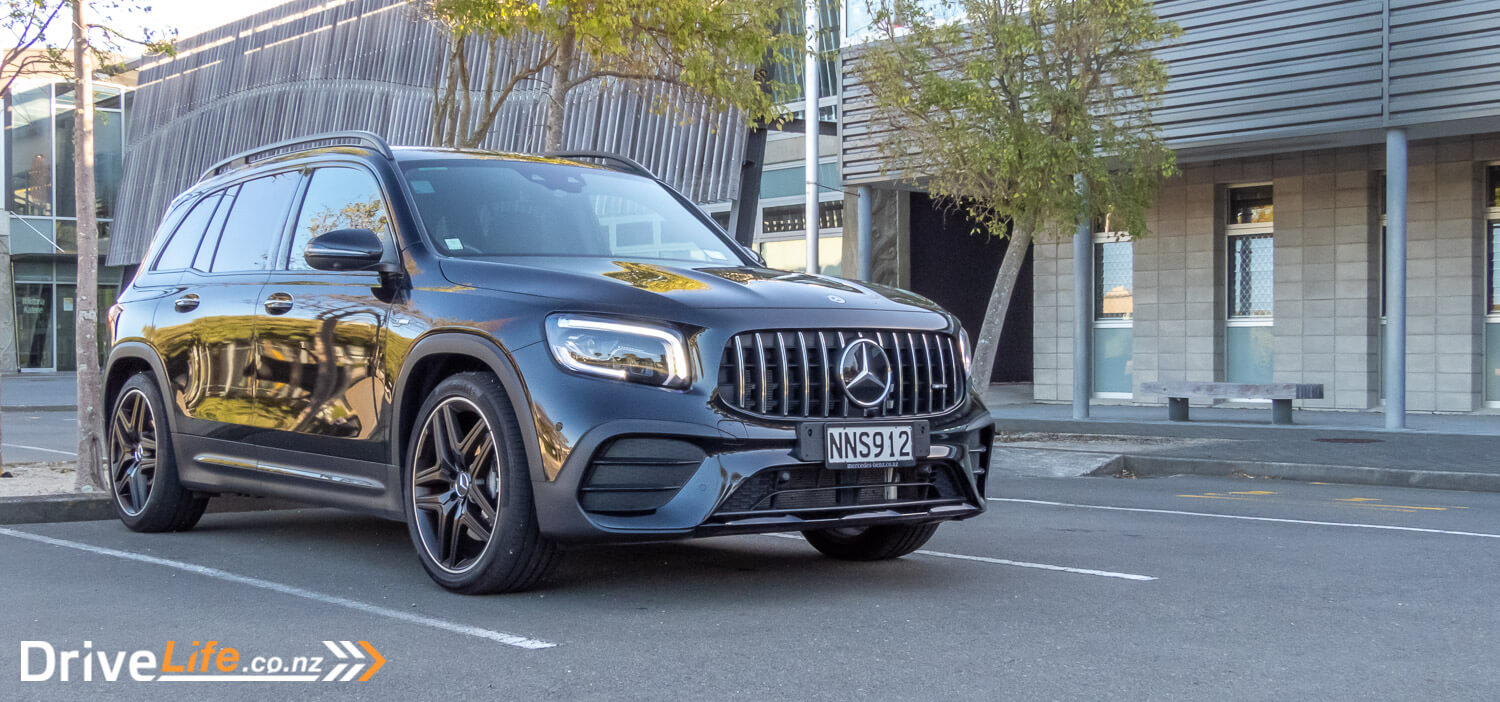
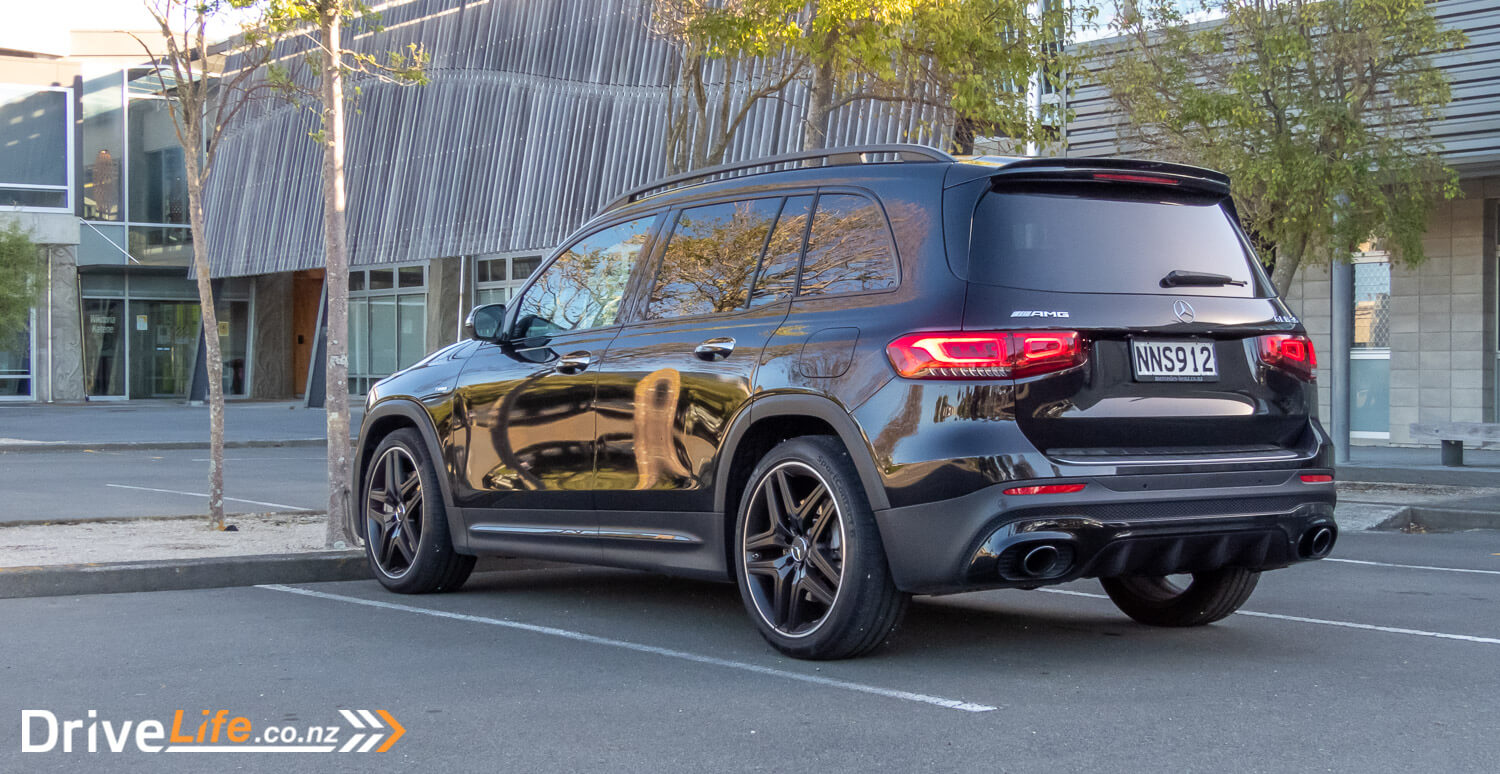
How Does The 2022 Mercedes GLB 35 AMG Compare To Its Competition?
The GLB 35 AMG isn’t alone when it comes to small performance SUVs. But, the GLB does have an edge. It’s the only one with 7 seats.
| Make/ Model | Engine | Power/Torque kW/Nm | Seats | Fuel L/100km | BootSpace,litres | Price |
| Porsche Macan | 2.0-litre 4-cylinder turbo | 195/400 | 5 | 9.3 | 488 | $115,800 |
| Audi RSQ3 | 2.5-litre 5-cylinder turbo | 294/480 | 5 | 9.8 | 530 | $116,500 |
| Mercedes GLB 35 AMG | 2.0-litre 4-cylinder turbo | 225/400 | 7 | 8.3 | 565 | $114,200 |
| Volkswagen Tiguan R | 2.0-litre 4-cylinder turbo | 235/400 | 5 | 9.7 | 615 | $80,990 |
| Cupra Formentor VZ | 2.0-litre 4-cylinder turbo | 228/400 | 5 | 7.7 | 345 | $71,500 |
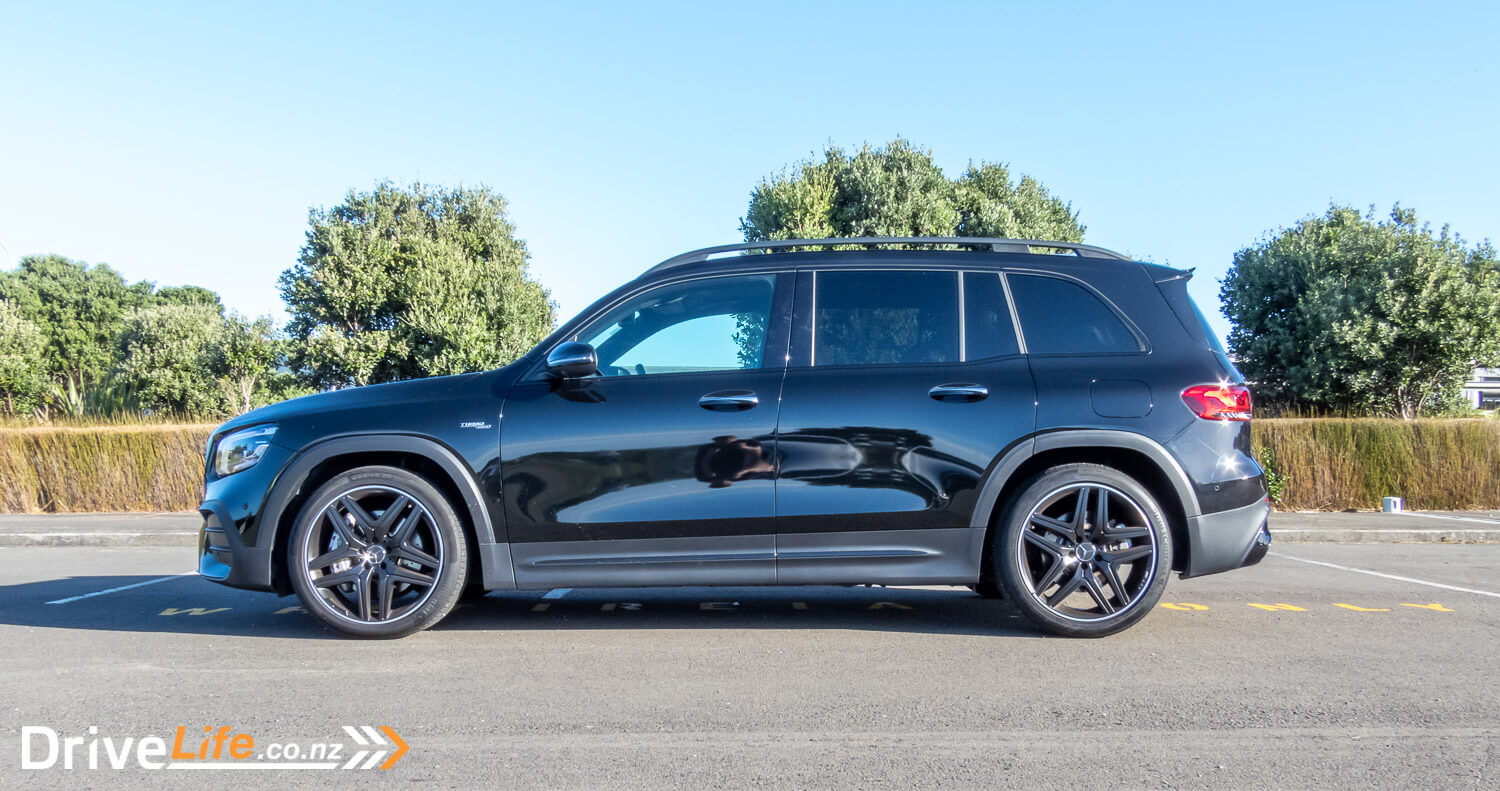
First Impressions Of The 2022 Mercedes GLB 35 AMG
It takes more-than-a-moment to figure out where the design cues come from for the Mercedes GLB. One part of me sees the scaled down proportions of a GLS, Mercedes’ large 7-seat SUV. Another part sees boxier elements as if the GLB-35 was the product of a one-night stand between the Mercedes GLA and a Mercedes G-Wagon. Either way, it’s distinctively Mercedes on the outside, even if you can’t tell who the parents are.
Being an AMG model, Merc has tarted up the exterior with large 20’’ AMG alloys, more aggressive bumpers, faux splitters and exhaust tips. The whole SUV rides 50mm lower than the standard GLB, with roughly the same ground clearance as the Mercedes A-Class hatchback.
It all looks fairly good, if I’m honest. Although, I wasn’t a fan of the 20’’ AMG alloys. Mercedes offers a range of alloy types, so I’d pick another if it were my call.
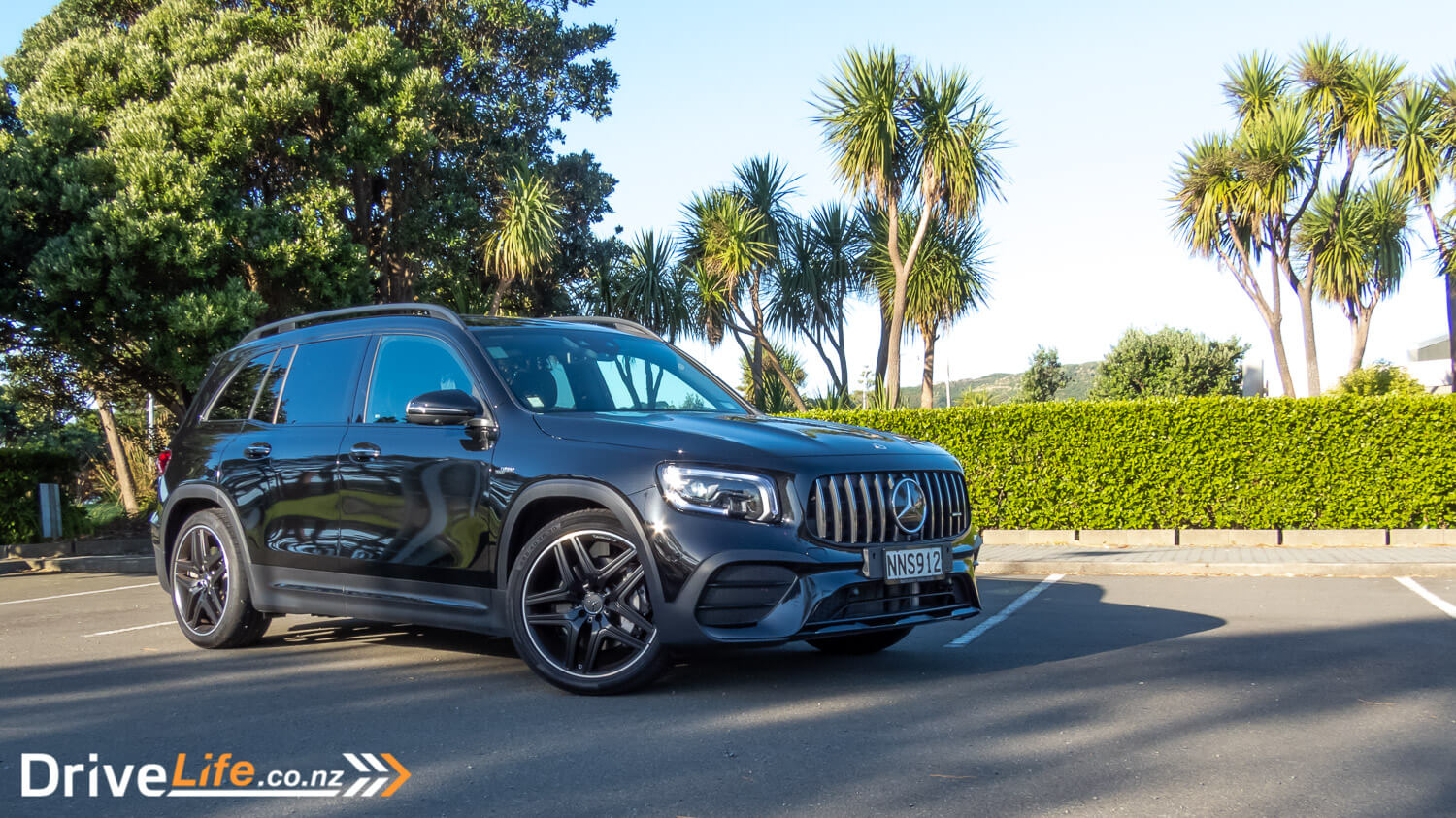
What’s The Interior Like In The 2022 Mercedes GLB 35 AMG?
Mercedes has a few standardised interior designs which are shared across different Mercedes models. Mercedes isn’t alone in this category. Both Audi and BMW do the exact same thing. From the driver’s perspective, GLB’s interior looks virtually the same as those found in the Mercedes A-Class, the B-Class, the GLA, the electric EQA, and other models of GLB.
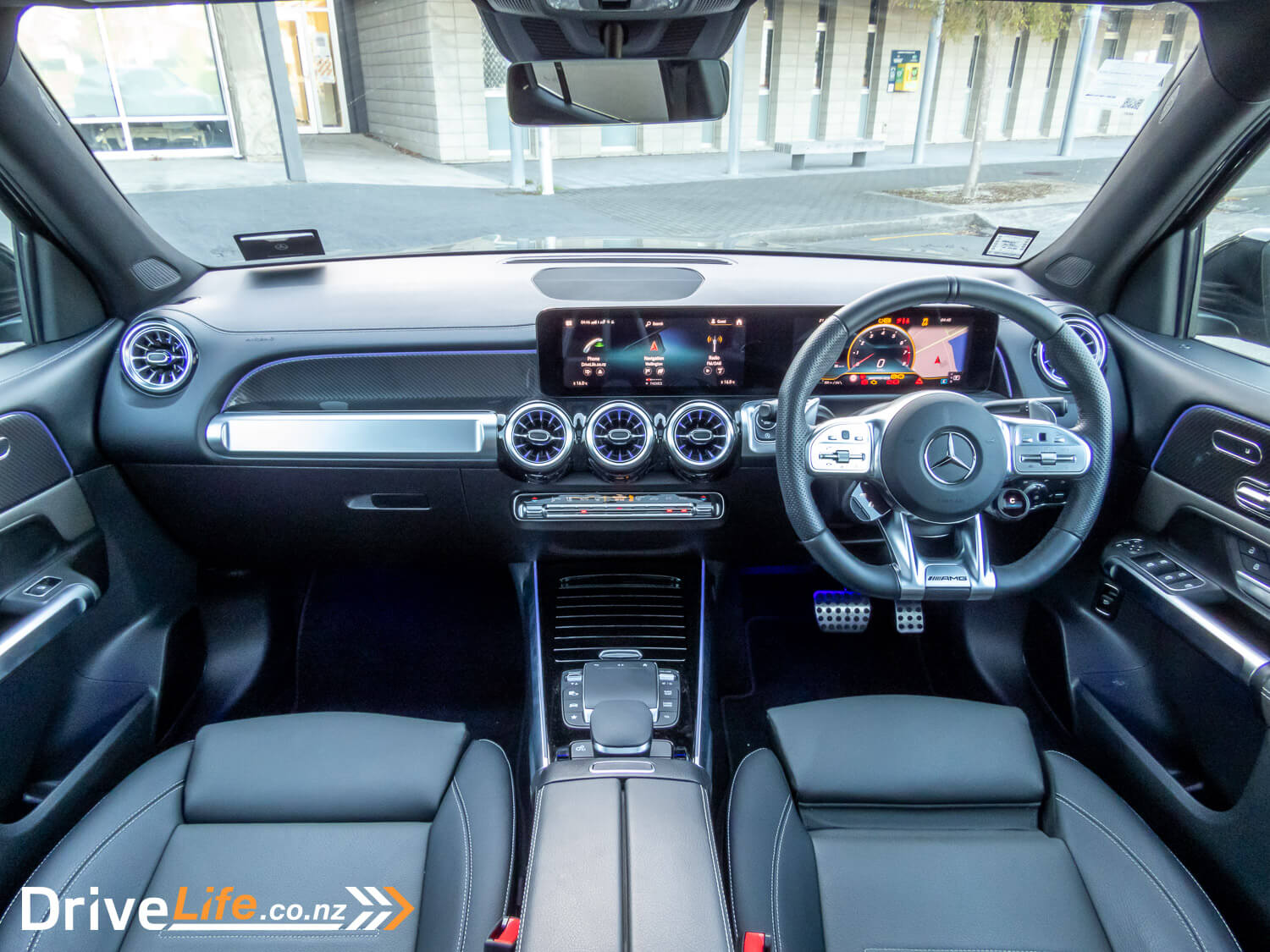
Some would argue that standardised designs are a cynical cost-cutting measure. Some might also be disappointed at the loss of vehicular individuality. However, a standardised design also means the manufacturer can invest more development dollars into a single design. The manufacturer, in theory, can dedicate their resources into getting it right.
By-and-large, this is true of the Mercedes GLB 35. Inside, the cabin is light and spacious. The build quality is excellent, plus the switchgear and other touch points are all top-notch.
Although, as good as it is, I still have a love/hate relationship with it.
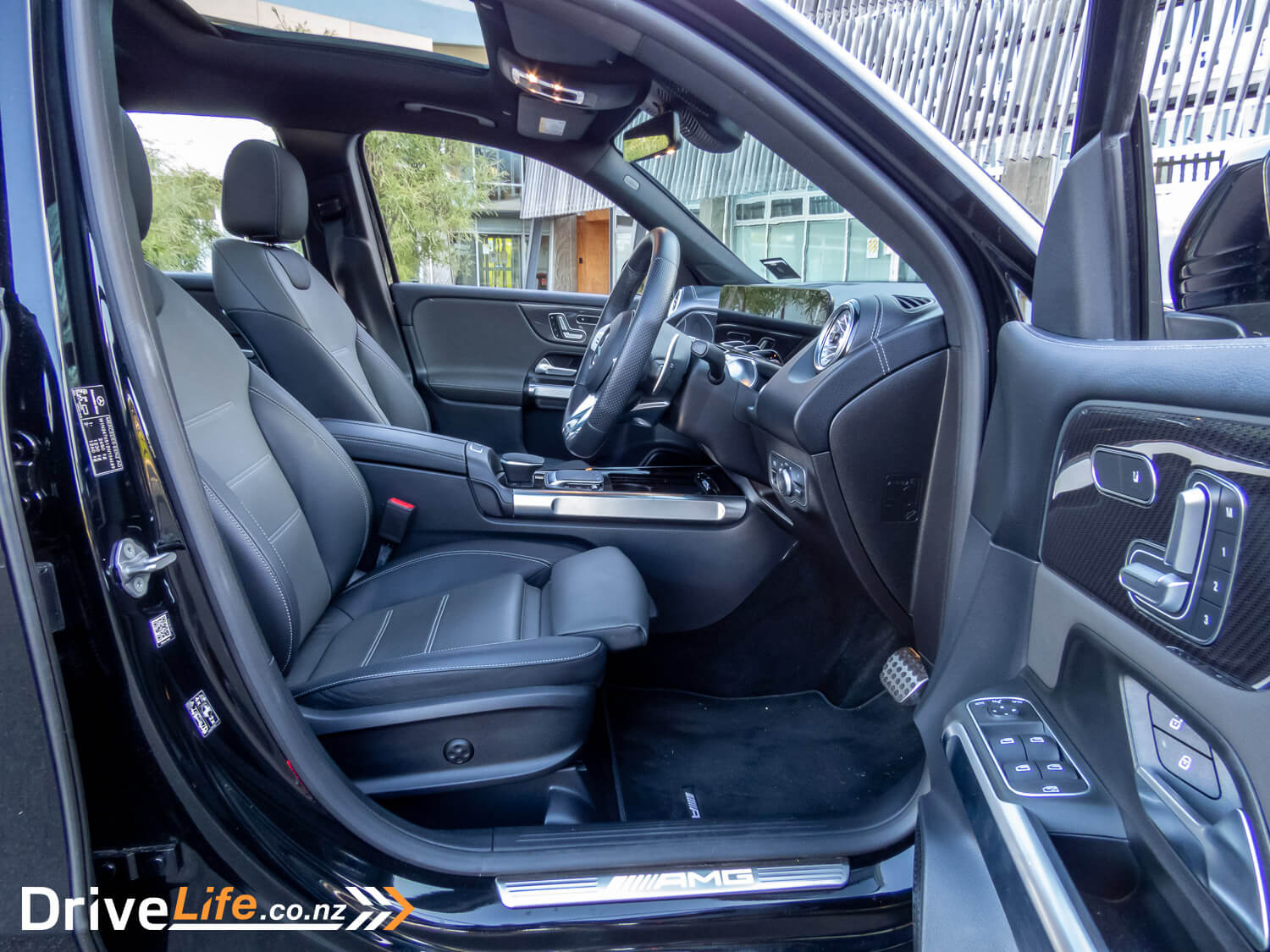
There’s a mishmash of different materials used in the GLB 35 AMG. The leather topped dash features a prominent carbon-effect trim inlay, which continues across onto the doors. There’s some alloy tube adhered to the console, doors and dash. The switchgear and climate vents have a metallic finish, while the centre console is trimmed with piano black plastic. Then, there’s enough LED strip lighting to rival Auckland’s K’ road on a Friday night.
Individually, all of these pieces are rather nice. But together, the design is just a tad too busy for my liking.
I also dislike the fake carbon trim. It looks tacky, and belongs nowhere on a $100,000 Merc. Granted, you can spec this differently on other Mercs, but it’s a standard trim for AMG and AMG line packaged vehicles.
The twin MBUX infotainment and dash cluster is also another point of contention. On the one hand, it’s one of the most well-developed systems you’ll find in any car. The resolution is crisp, the interface is logical, and the colour levels and graphics are top notch. It’s also as responsive as some of the best smartphones. The infotainment is connected to a series of hi-res cameras with dynamic guidance. These cameras are also among the best in the business.
On the other hand, the infotainment is controlled with a track-pad mounted to the centre console, which is a difficult system to master. Fortunately, it’s also a touchscreen, but the screen coating will leave more fingerprints than a crime scene after a few days of using it.
The dash cluster side is endlessly configurable. There’s nearly 100’s of ways you can arrange the cluster. AMG cars also get added screens, to include power gauges and g-meters. You can also set the theme of cluster too, depending on whether you want sporty-look gauges or a more traditional look.
As fun as it can be to play with all the options, the reality is that you’re going to set it one-way, and never touch it again.
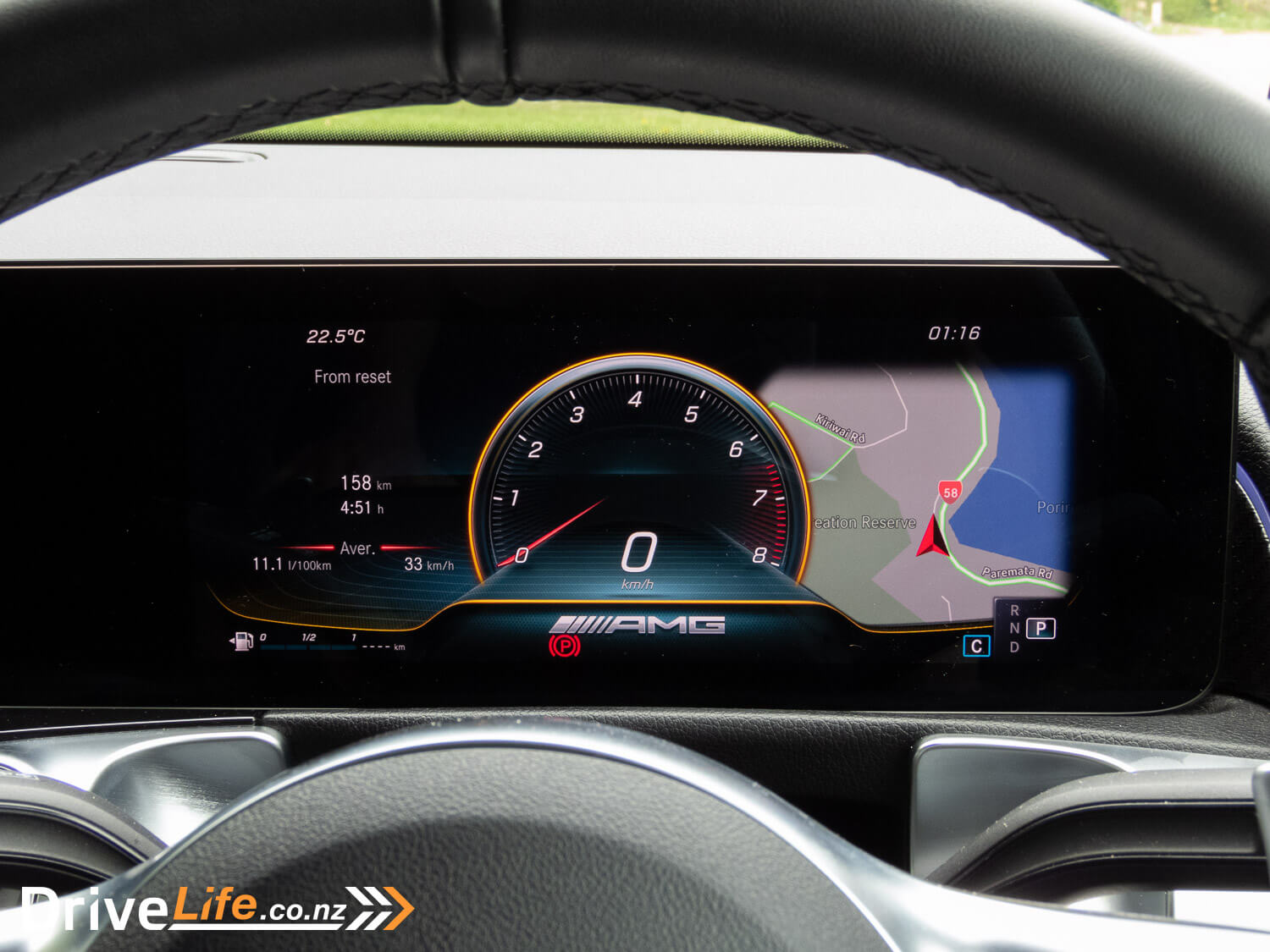
The steering wheel is a complete cluster bomb of controls. Then, AMG has gone and glued all the AMG drive controls onto it too. In reality, the steering wheel isn’t so intimidating once you’ve learned it. The only tricky part is using those black haptic tiles for scrolling through menus.
I also wish Mercedes would put a simple music track button on the steering wheel. Instead, this function is controlled with the haptic controls, but it’s not so easy to get it right.
Speaking of those AMG controls, they contain small displays which change depending on the drive mode. The round dial adjusts the pre-set drive modes, while the two controls on the left adjust the dampers and power-train responsiveness independently. For whatever reason, Mercedes has also included several other ways to adjust the drive mode settings. There’s a drive mode switch on the left side of the infotainment track-pad. There’s another button for the dampers just above it, next to the hand rest. You can also use the touch screen to configure your drive mode settings too.
Why are there so many ways to do it? I’m not sure. At least they’re not blank switches, I suppose.
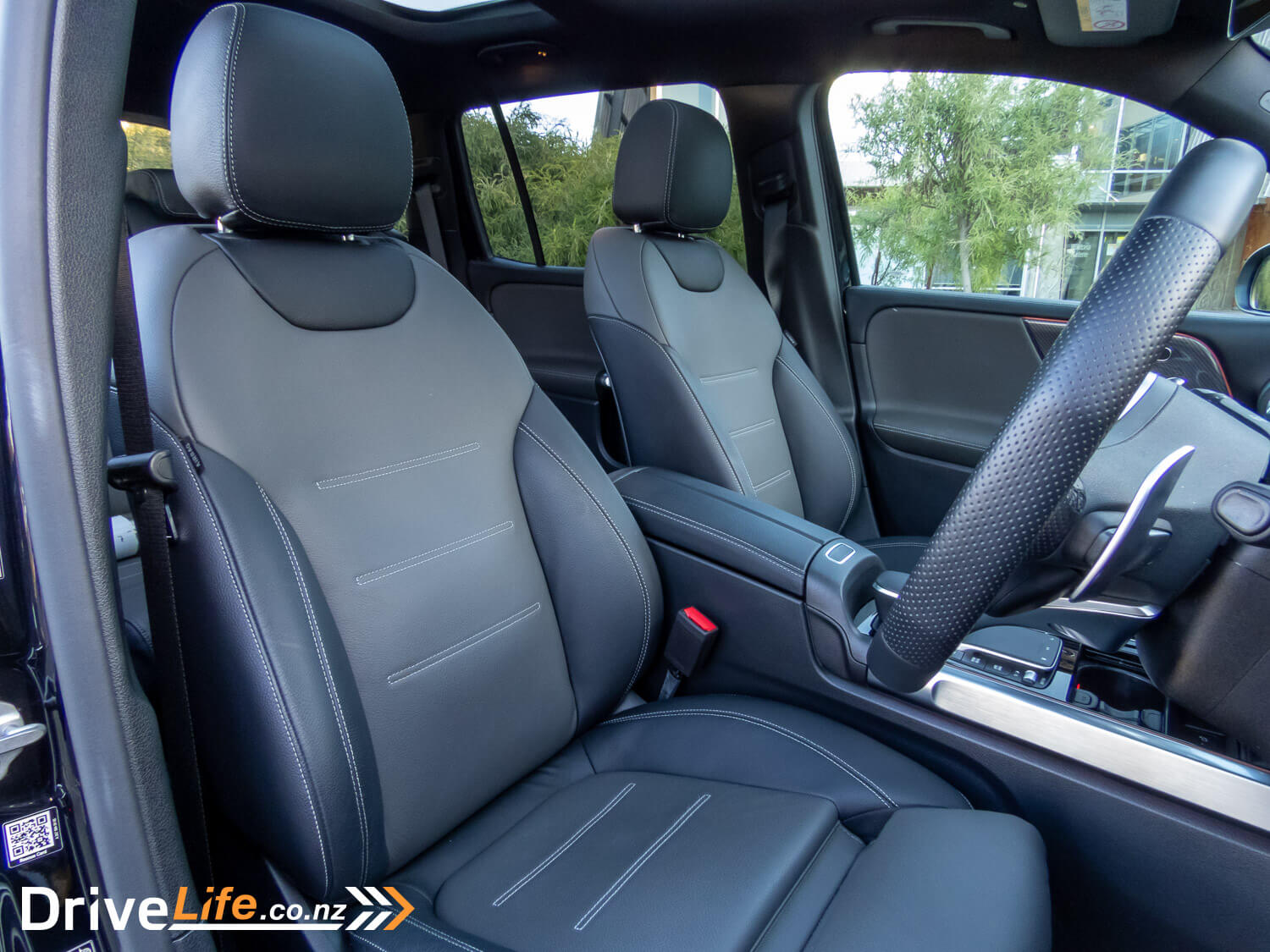
Returning to the front, the driver’s and passengers’ seats are excellent. They’re slightly on the firm side, but they’re supportive and highly configurable. Getting comfortable wasn’t an issue. According to Mercedes-Benz, the GLB is also class-leading for headroom too.
There’s also plenty of space in the second row. The seats are on rails, allowing you to slide them all the way back if you need to stretch your legs. Children in the back will also enjoy the view out, thanks to the high seat base and the low door sills. There’s also a couple of USB-C ports to keep their devices charged.
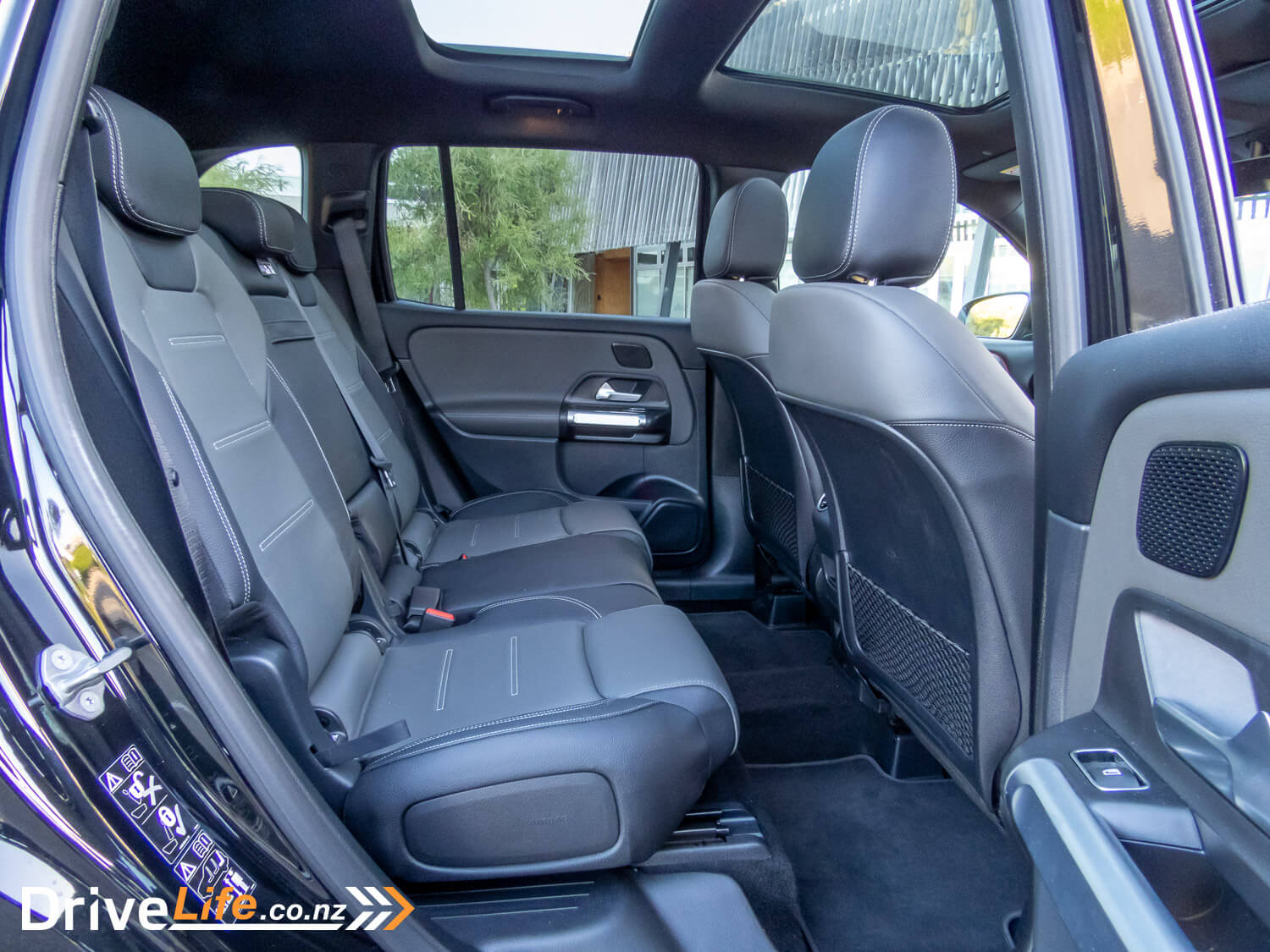
The third row is a different story. It’s more of an occasional third-row, or a place for very young children. At least the third-row passengers get a USB-C port on each side and also cup holders in between the seats. There’s also ISOFIX tethers back there too.
With the third row up, boot space is certainly not generous but that’s typical of a small 7-seater. Drop the seats, you’ll get a generous 565 litres of space. There’s also deep underfloor storage, hiding a retractable parcel tray and a bunch of other safety gear.
Finally, my last comment regarding the GLB relates to the doors. When opened, the doors seem to open very close to the curb. It made me paranoid about grazing them. Also, there were several occasions where I couldn’t close the doors properly either, meaning an unnaturally harsh door pull was necessary to get them properly closed. It happened enough times for me to conclude it wasn’t an accident either.
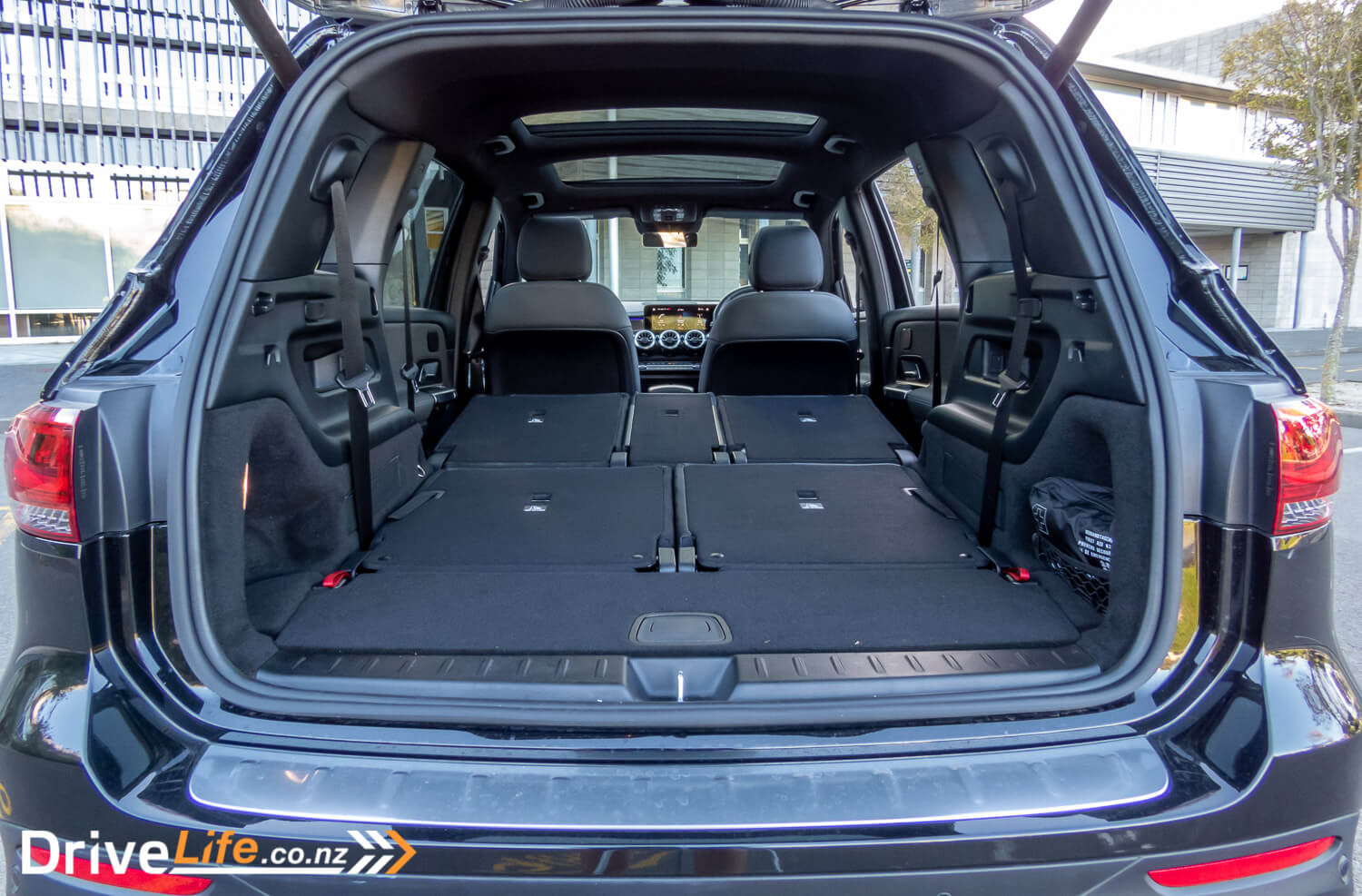
What’s The 2022 Mercedes GLB 35 AMG Like To Drive?
Underneath the hood of the GLB 35 is the same turbocharged 2.0-litre 4-cylinder found in other 35 AMG vehicles, like the A35 AMG and the GLA 35 AMG. Like those two, the engine produces 225kW of power and 400Nm of torque. The GLB shares the same 8-speed dual clutch transmission (DCT) in the GLA, whereas the A35 AMG uses a 7-speed DCT. Power is sent to the wheels via Mercedes’ own 4-Matic all-wheel drive system.
The GLB 35 also has six programmable drive modes, these being Comfort, Eco, Sport, Sport +, Individual and Slippery. Adjusting the modes will tweak the responsiveness of engine and the gearbox, vary the traction control and either soften or firm-up the suspension based on the selected mode.
With 225kW and 400Nm on tap, you’d expect the GLB 35 to have the performance to get-up and boogie. Granted, the GLB 35 isn’t exactly a feather weight. With a kerb weight of 1857kg, it’s 304kg heavier than the GLB 200. You can thank the 4-Matic all-wheel drive system, plus all the extra chassis bracing and other performance parts for the additional weight.

Between 400Nm and 4-Matic all-wheel drive, the GLB does a pretty good job concealing its weight. 0-100kph is dispensed in 5.2 seconds and the GLB will climb to an electronically limited top speed of 250kph.
Despite being a turbo 4-pot, the engine pulls strongly through-out most of the rev range. It’s almost as if AMG’s engineers wanted the 4-cylinder to have the robust pulling power of its larger engines. In Sport +, the engine feels more eager and responsive, but like John experienced with the GLA 35, I was expecting it to be a tad more raucous.
The GLB 35 also generates a reasonable noise. The noise isn’t going to impress an AMG fanboy, but in an age of petrol particulate filters, it’s enough to draw a smile. It’s difficult to tell if there’s some cabin sound trickery going on, because it doesn’t sound completely organic. All said, it was enough to spur me on when driving quickly.
While the engine is a fairly robust unit overall, it does lack a bit of character. The engine is not particularly high revving, nor are there any interesting parts of the rev-range. Aside from the noise, there wasn’t anything coaxing me into driving it hard. Perhaps it’s a tall order for the GLB 35, or any crossover even, but I was expecting more from AMG.
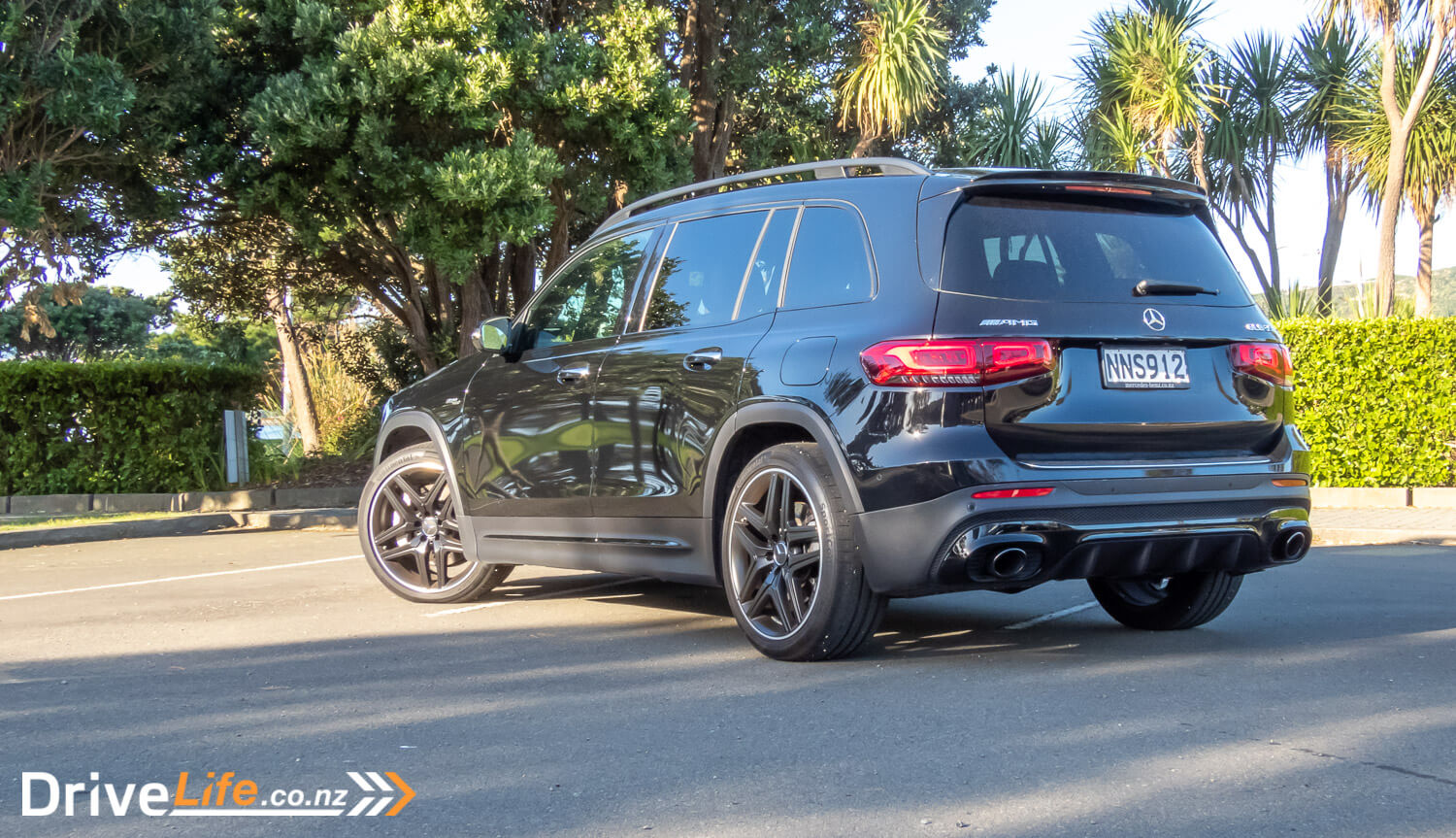
The 8-speed DCT has little hesitation, but only when the wheels are already turning. If you’re heavy footed from a stand-still, or even at a low speed, there’s a good few seconds’ delay before anything happens. Even with the GLB in its most aggressive settings, there was still a launch delay.
I suspect the GLB 35 computers were thinking you were going to enter launch mode, which can be achieved by brake boosting the car. Most of the time, you’re not trying to launch but just get ahead of traffic, which seems to confuse it. In all other settings, the DCT was a superb gearbox. I had few issues with it in traffic. It also passed the uphill reverse test, which is known to confuse a few DCTs.
Of all performance virtues of the GLB 35, handling was probably one of the bigger surprises. Mercedes has beefed up the GLB 35’s chassis with a stiffer subframe, unique front suspension arms and additional chassis bracing. The rear suspension is a multi-link set-up, as opposed to a trailing link on the other GLB vehicles. There are also the adaptive dampers in all corners, which firms each corner up in sportier settings. The GLB is a stiff crossover, and you can feel it.
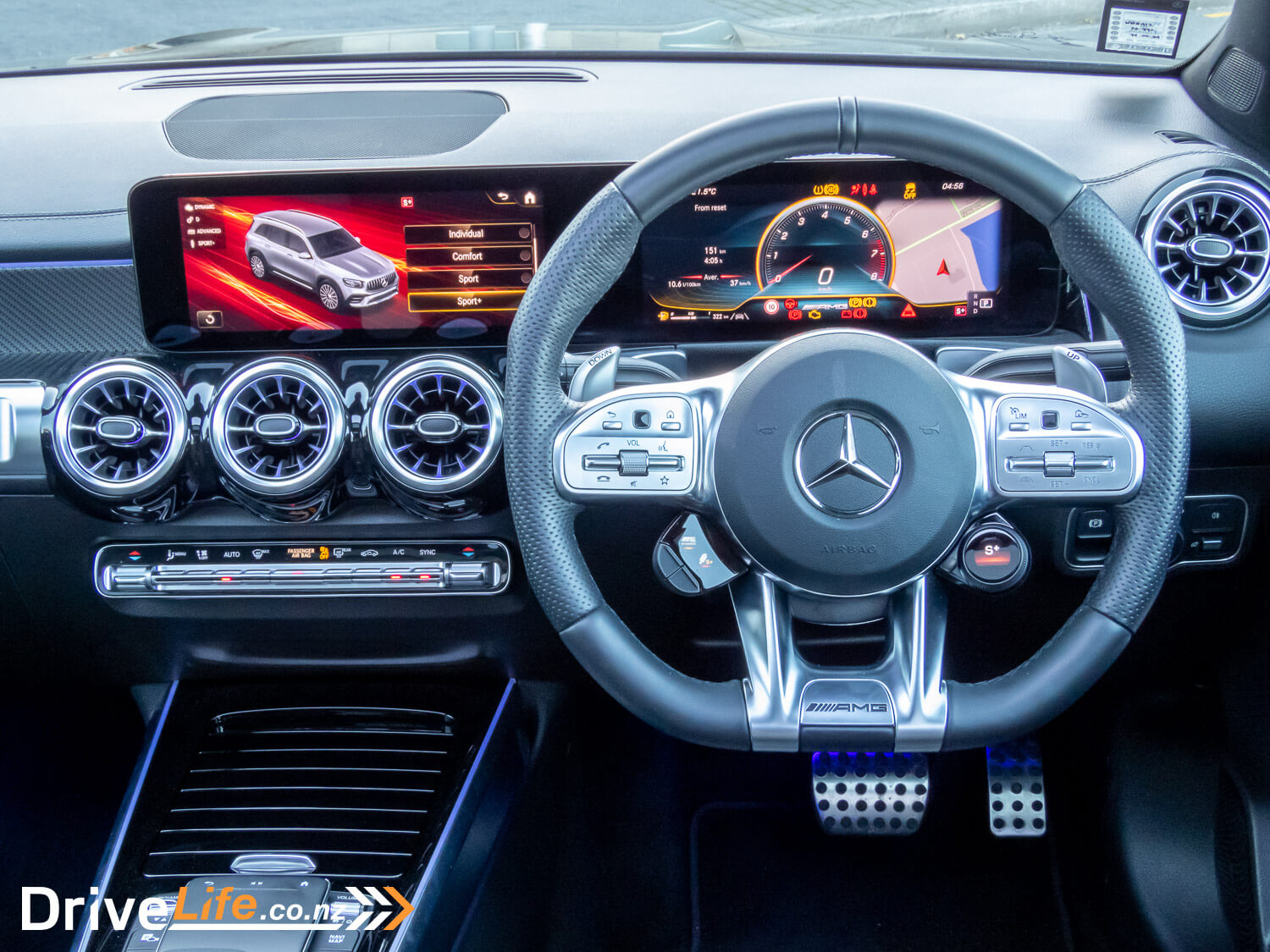
Flick the car into Sport +, and start entering corners with some velocity, you’ll be impressed with what this heavy crossover can achieve. The steering is direct and responsive, while loading the tyres nicely and progressively. When the going gets serious, the body does lean slightly and the nose does want to push outwards. But, that’s a friendly way of the GLB showing you its boundaries, before physics takes its revenge. All-in-all, the GLB 35 is a fairly sharp instrument for a crossover. You can definitely have some fun in this car when you’ve completed the school run.
Despite the stiff chassis, the GLB 35’s ride quality is also competent. Flick into Comfort mode, and adaptive dampers slacken off, helping smooth out road bumps and undulations. Even though you can still get hints of its stiffness, the adaptive dampers do most of the heavy lifting.
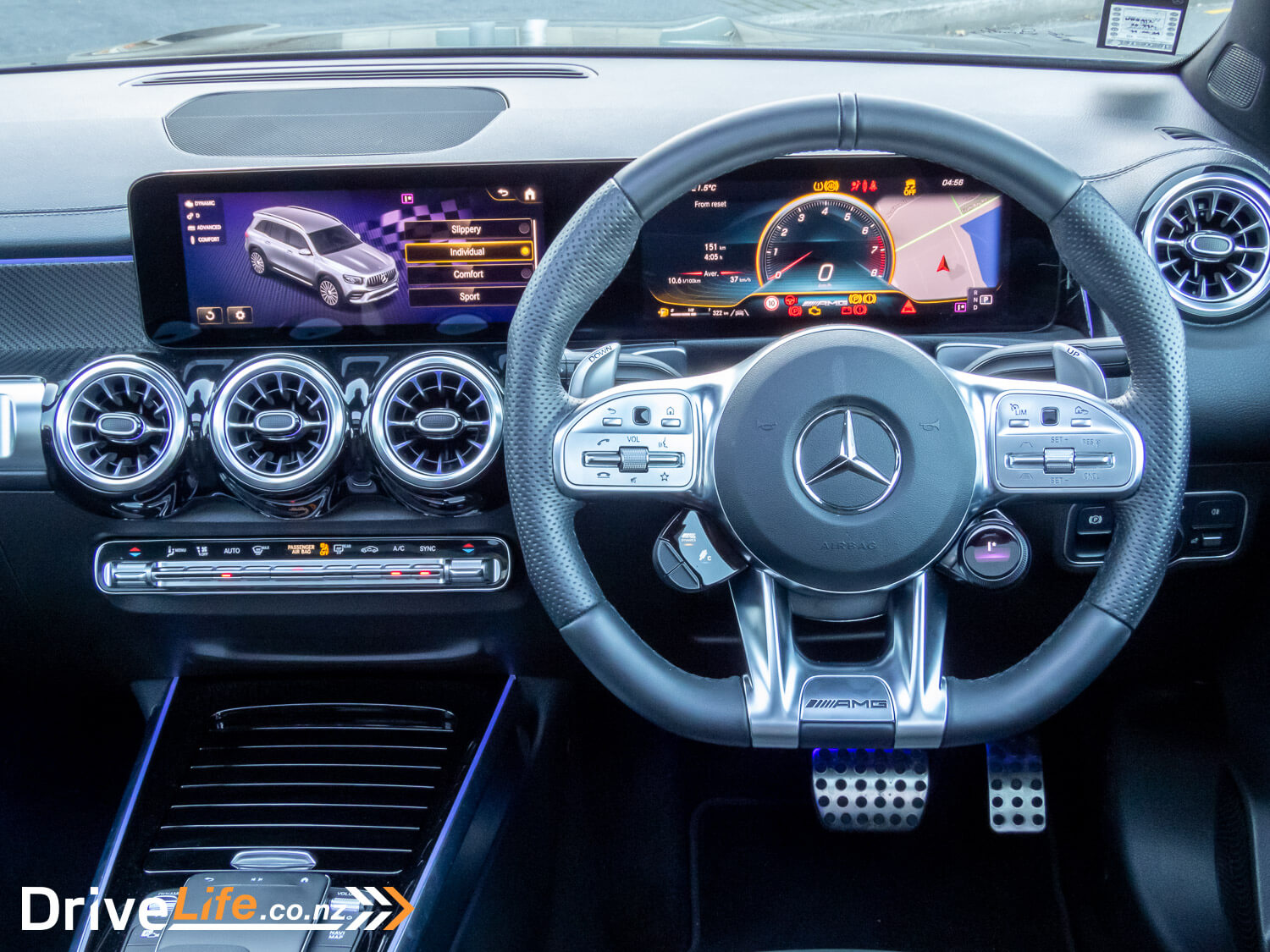
It’s pretty good, all things considered. Some AMGs can make you feel like you’re riding on a bed of rocks when you drive down to your local supermarket, but the GLB 35 does the split personalities well. I actually spent most of my review in Comfort mode – which is honestly a bit shocking for me to say about an AMG.
Under the 20’’ AMG alloys are a set of large silver AMG brake callipers. Judging by their size, you’d expect the GLB 35 to have the stopping power to rearrange the contents of your stomach. In reality, the GLB’s brakes are much more progressive. The braking is confident, but not as powerful as those callipers imply. There’s not a great deal of pedal feel either. The brakes should resist fade fairly well, but I doubt you’ll ever see a GLB 35 AMG on the race track.
At this stage, you might be thinking that GLB 35 is not so much a rowdy performance car, but rather a practical crossover with some spirit. Your judgment isn’t far off the mark. However, the GLB does have a few marks against it for being a practical daily as well.
For starters, if you’re considering any AMG vehicle, you mustn’t be averse to a weekly stop at the petrol station. Although Mercedes claims a fuel consumption figure of 8.3L per 100kms, during our test, we averaged a rate of 11.1L per 100kms. Ouch.
Admittedly, we aren’t inclined to nanny the throttle in an AMG, but even on more sedate runs, I struggled to get the figure down below 10L per 100kms.
The GLB 35 is also not the easiest thing to manoeuvre around town either. Sure, the steering is light at low speeds, but it’s turning circle is 12.5 metres! For some context, that’s only half a metre shy of the Mercedes GLS – their full-size 3-row SUV.
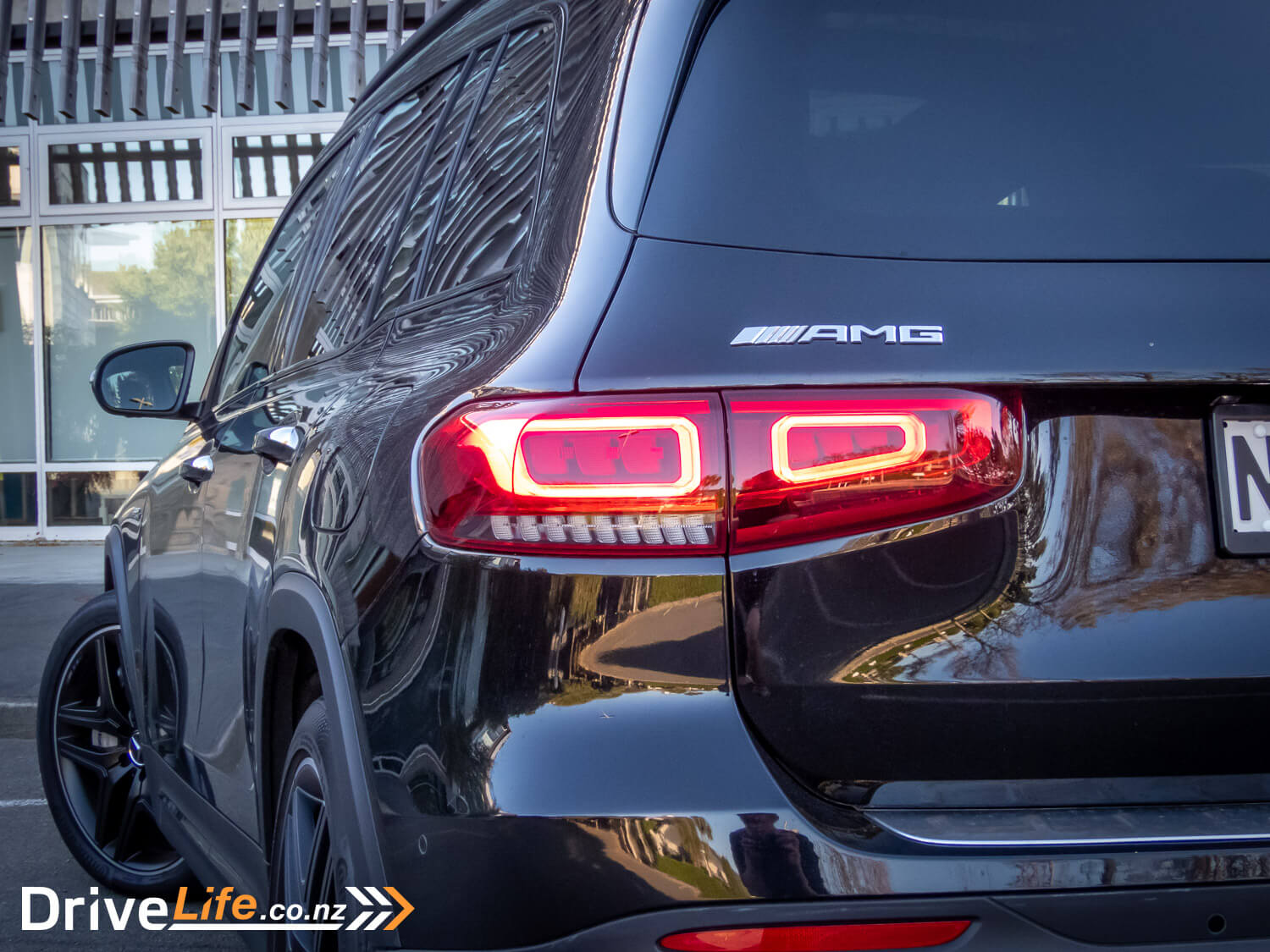
Mercedes is among the best when it comes to safety technology, particularly so with software like adaptive cruise.
While other brands do adaptive cruise control well, Mercedes does it nearly perfectly. All the inputs are smooth and progressive, and it’ll bring you to a halt in traffic. When the traffic starts to move again, it will move forward without any input from the driver.
Our test vehicle also had the optional Mercedes’ Route Based Speed Adaptation. When adaptive cruise is active, the car will track your route via GPS, and occasionally slow the GLB down for corners. Personally, I wasn’t a fan of this. It was a tad overbearing and would slow down for corners I’d comfortably hold at the speed limit.
Setting the cruise control is a single button interaction – it’s always on and ready to operate. There’s also another button which will set the cruise control speed limit to the speed of the mostly recently detected road sign. On that subject, the Merc’s traffic sign recognition software worked flawlessly during our test. It’s nice to have confidence in these support systems. With other brands, I’ve seen the traffic sign recognition software miss the mark so badly, that I even got a speed sign posting of 130kph in one car.
Although, there is one rather large problem with all this tech – it’s not standard. nstead, the Adaptive Cruise Control and the supporting features are part of the Driving Assistance Package, which is a $1,990 option. It seems absurd, given that you can get Adaptive Cruise Control as standard on a Suzuki Swift RS for $27,990. Sure, Mercedes’ system is excellent, but you’re already paying the badge premium. Why isn’t this standard?!
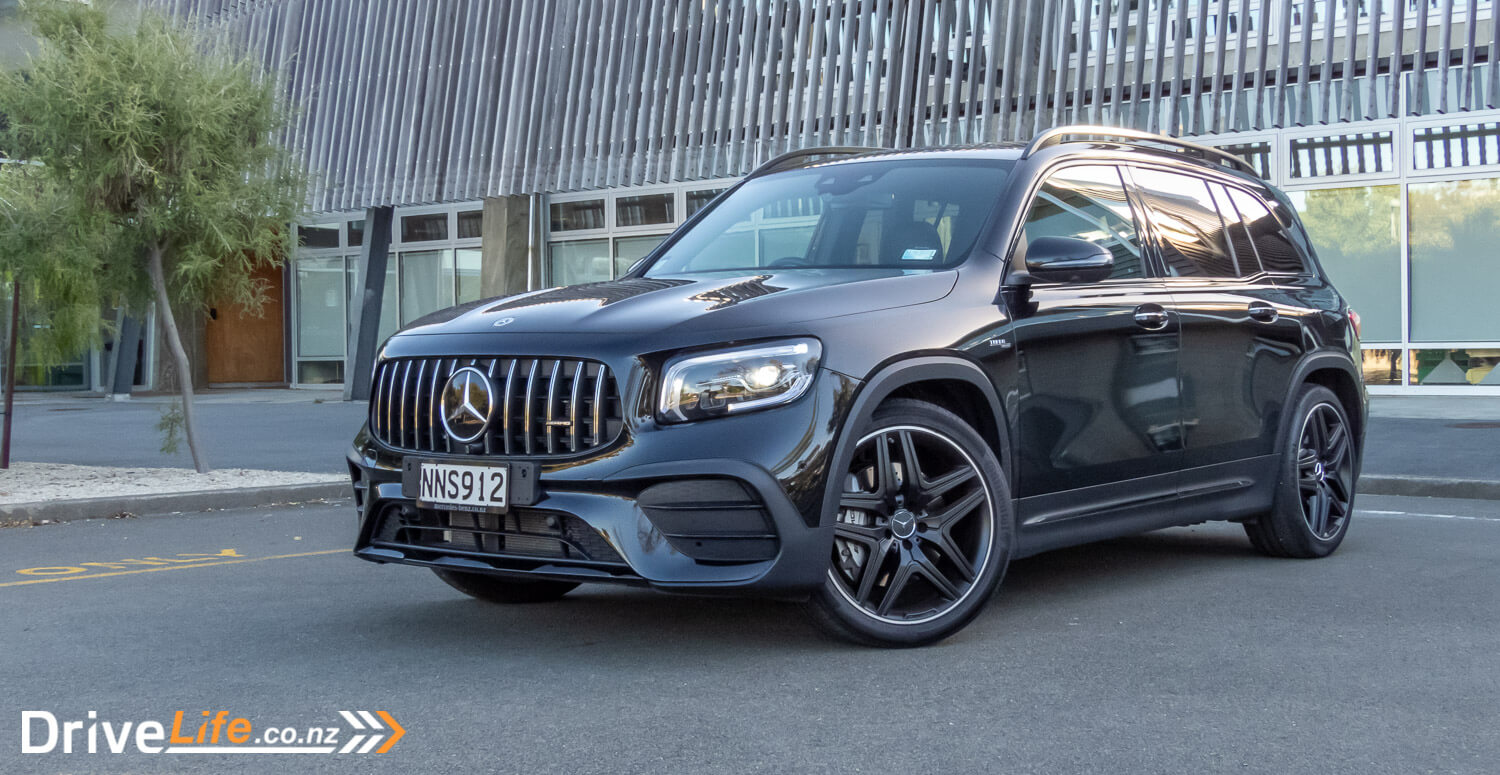
2022 Mercedes GLB 35 AMG Specifications
| Vehicle Type | 5-door, 7-seat Crossover SUV |
| Starting Price | $114,200 |
| Price as Tested | $119,660 |
| Engine | 2.0-litre turbo-petrol 4-cylinder |
| Power, Torque kW/Nm | 225/400 |
| Transmission | 8-speed dual clutch Automatic |
| Spare Wheel | Pump only |
| Kerb Weight, Kg | 1,857 |
| Length x Width x Height mm | 4650 x 1845 x 1660 |
| Boot Space / Cargo Capacity Litres (seats up/seats down) | 565 (second row in-place) 1,800 (second row down) |
| Fuel tank capacity, Litres | 66 |
| Fuel Economy, L/100km | Advertised Spec – Combined – 8.3 Real-World Test – Combined – 11.1 Low Usage: 0-6 / Medium Usage 6-12 / High Usage 12+ |
| Towing Capacity Kg, unbraked/braked | N/A |
| Turning circle, Metres | 12.5 Small: 6-10m / Medium 10-12m / Large 12m+ |
| Warranty | 3 year comprehensive warranty |
| Safety information | ANCAP Rating – 5 stars Rightcar.govt.nz – 5 Stars – NNS912 |
Have you enjoyed this review? Be sure to join our monthly email newsletter list so you don’t miss a single car review!


